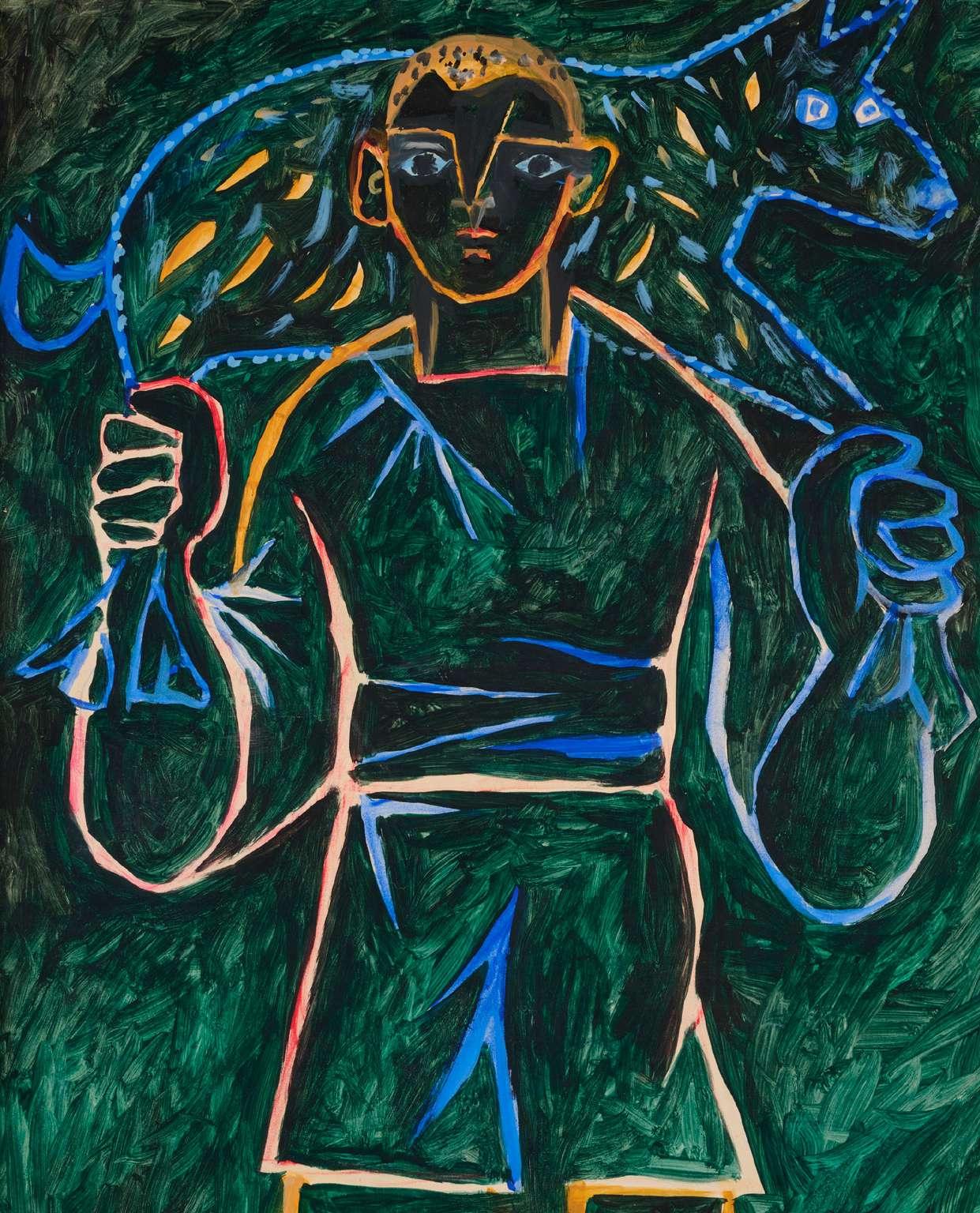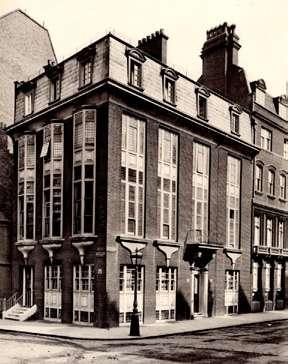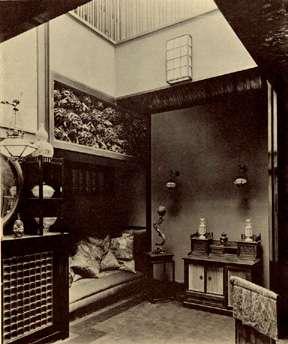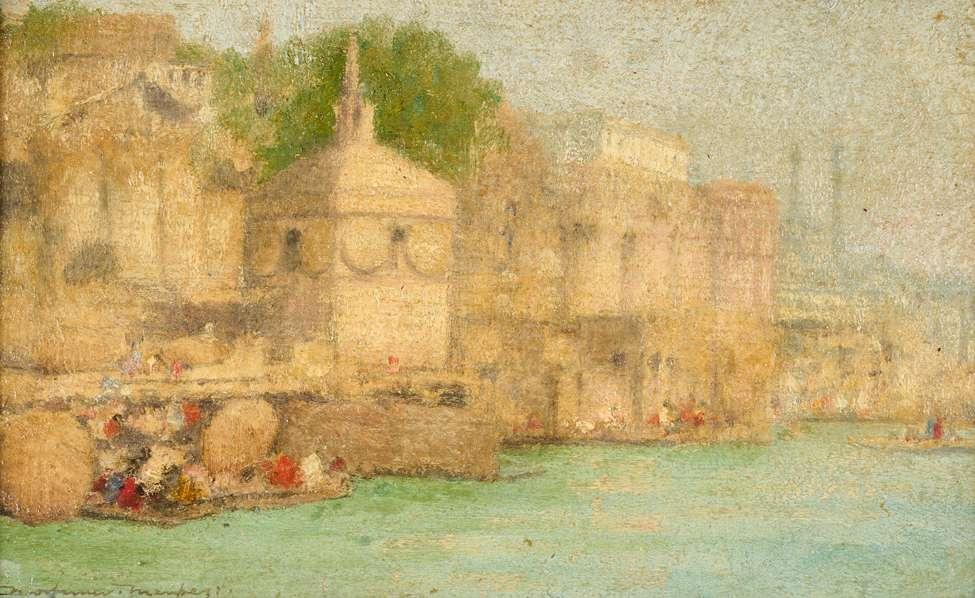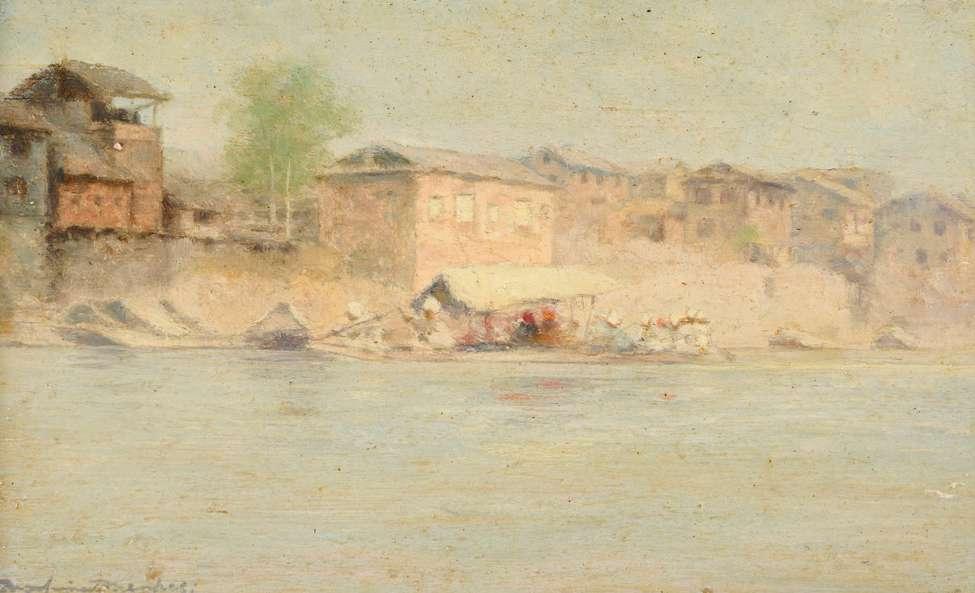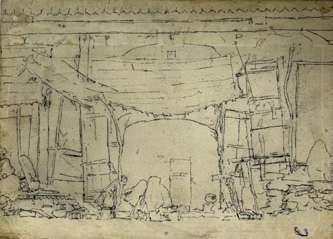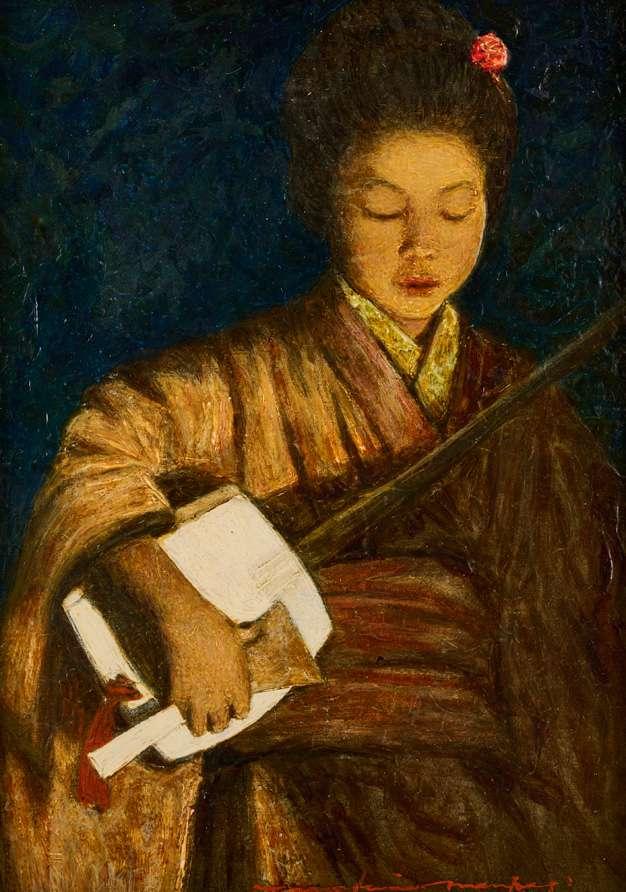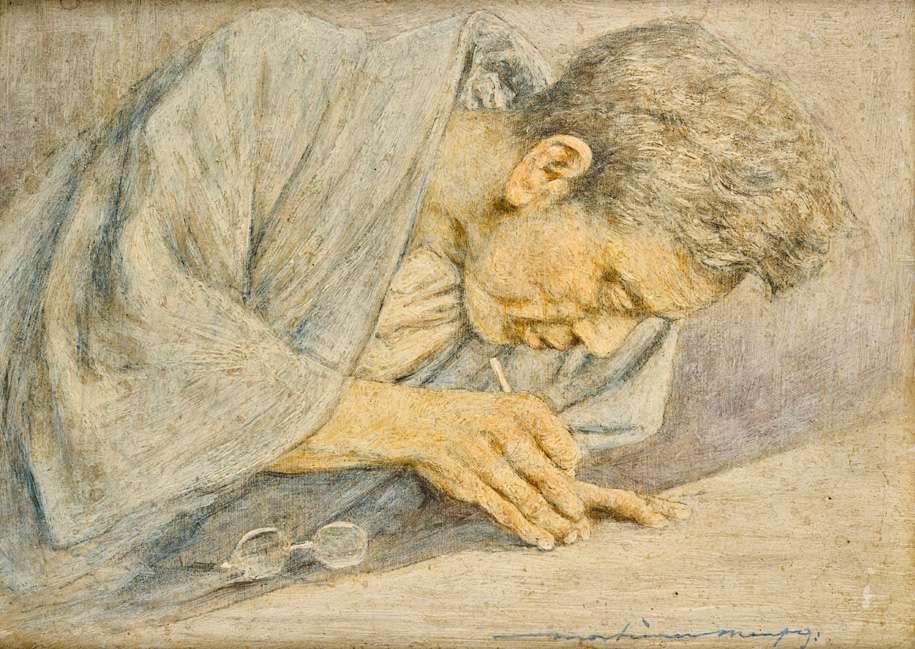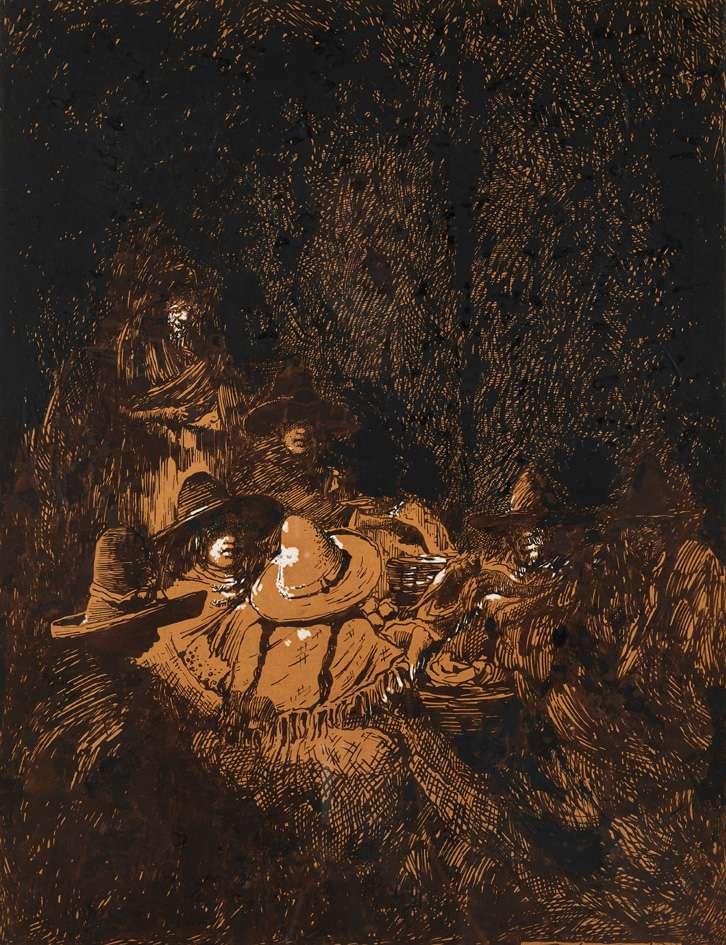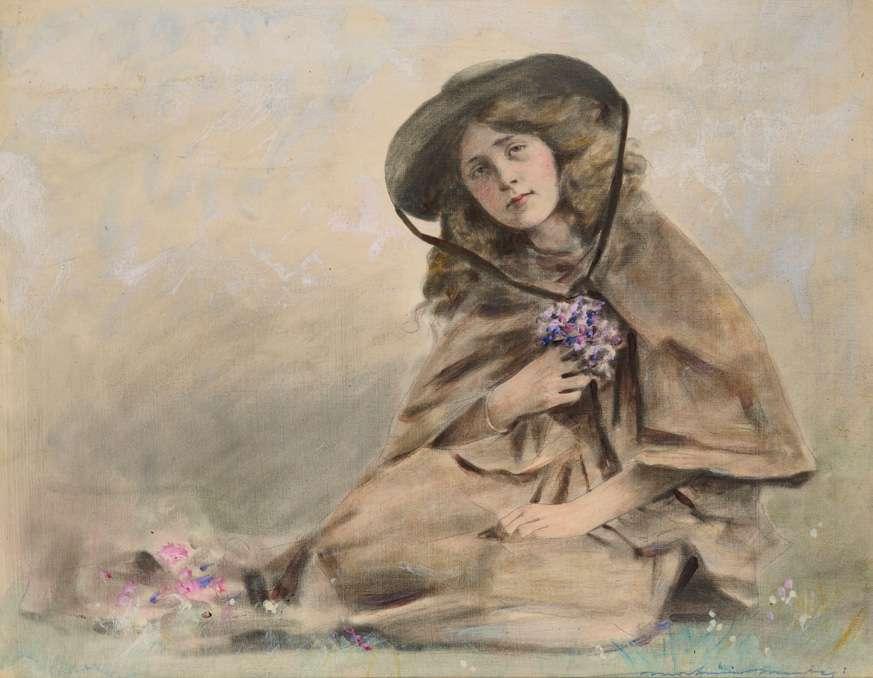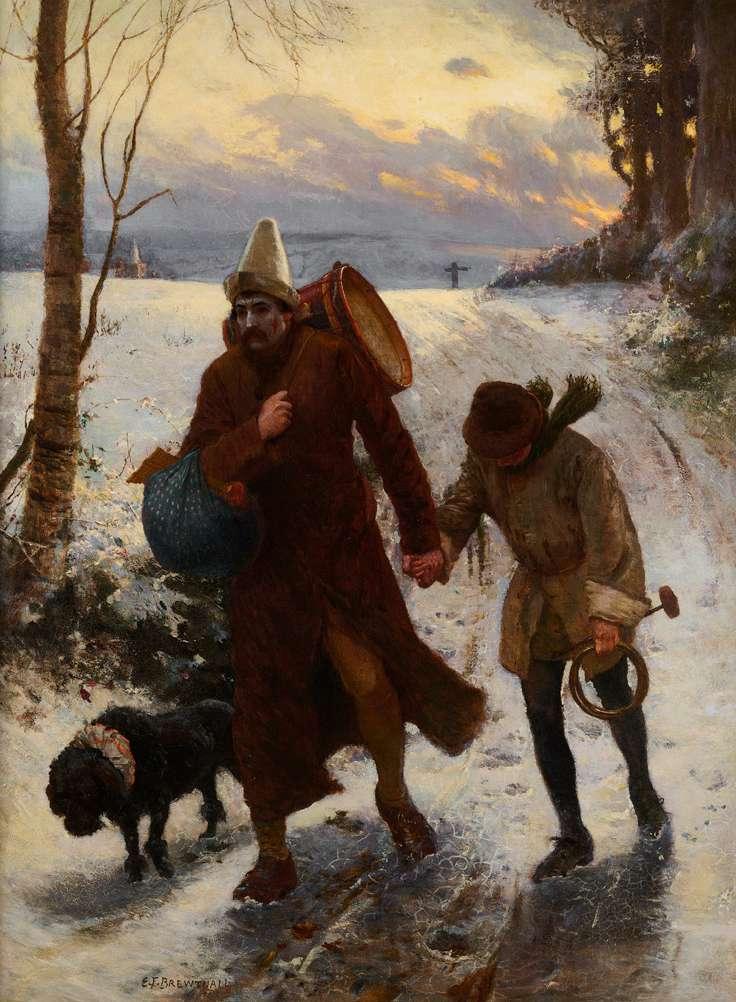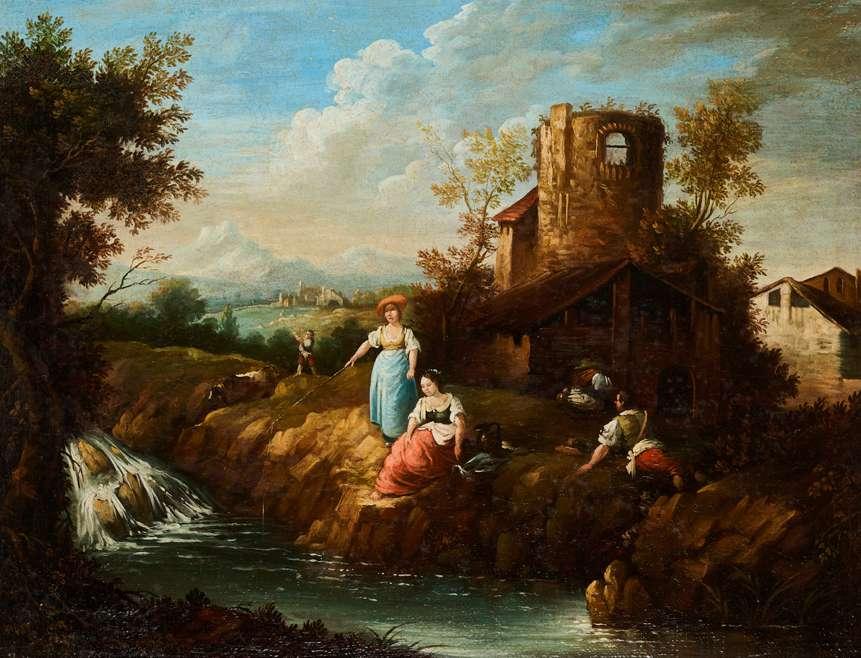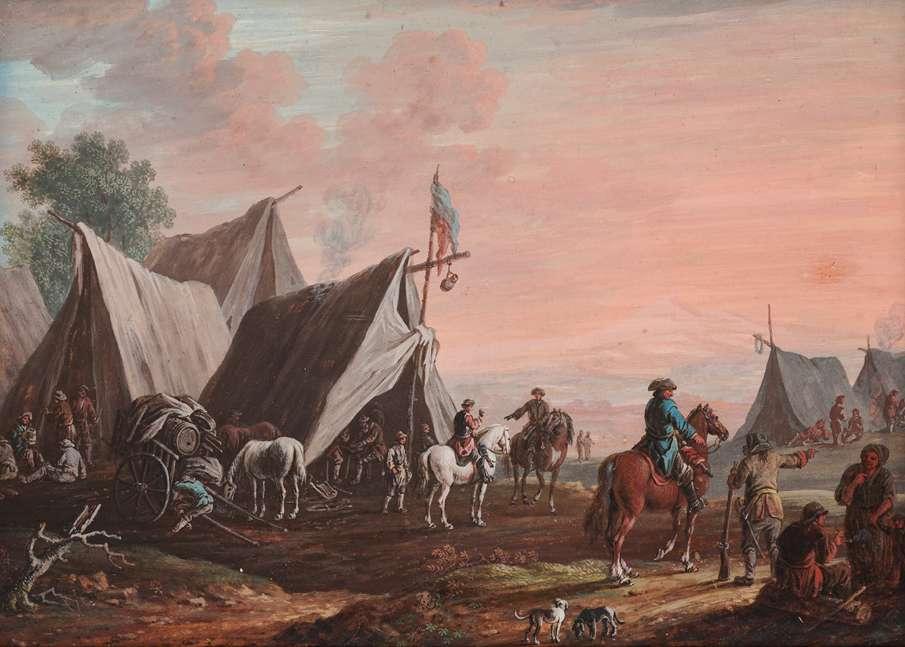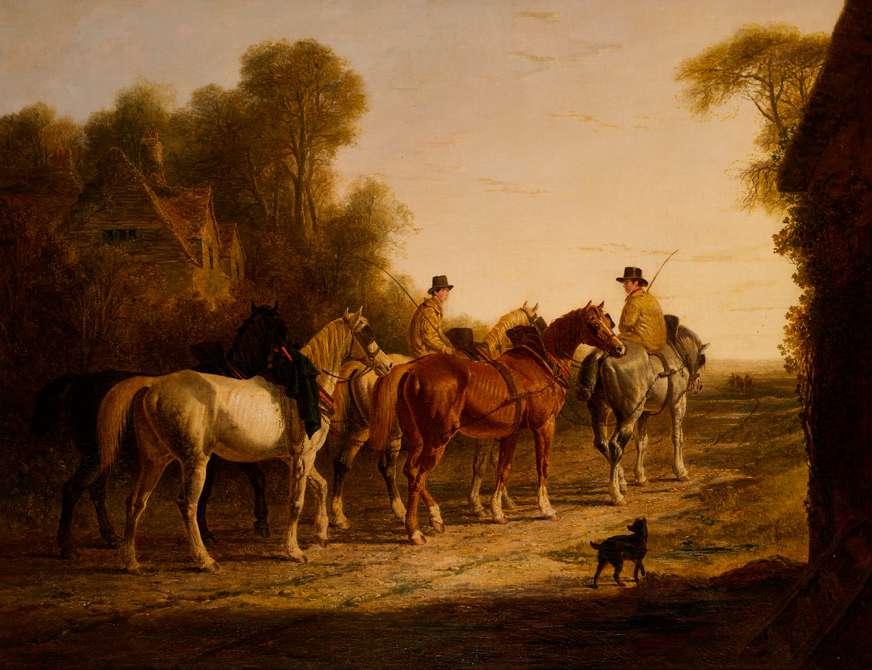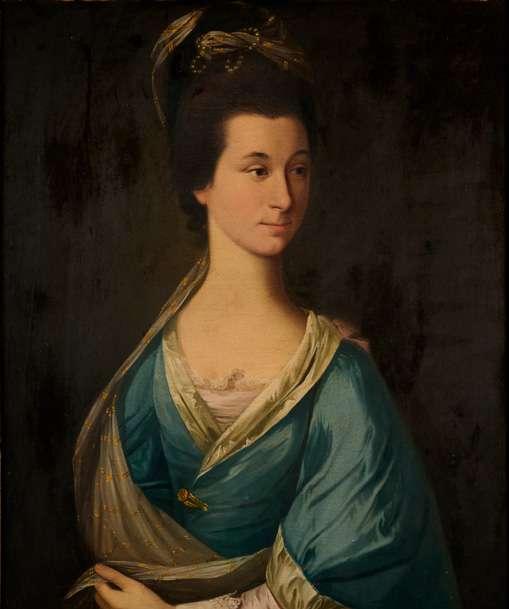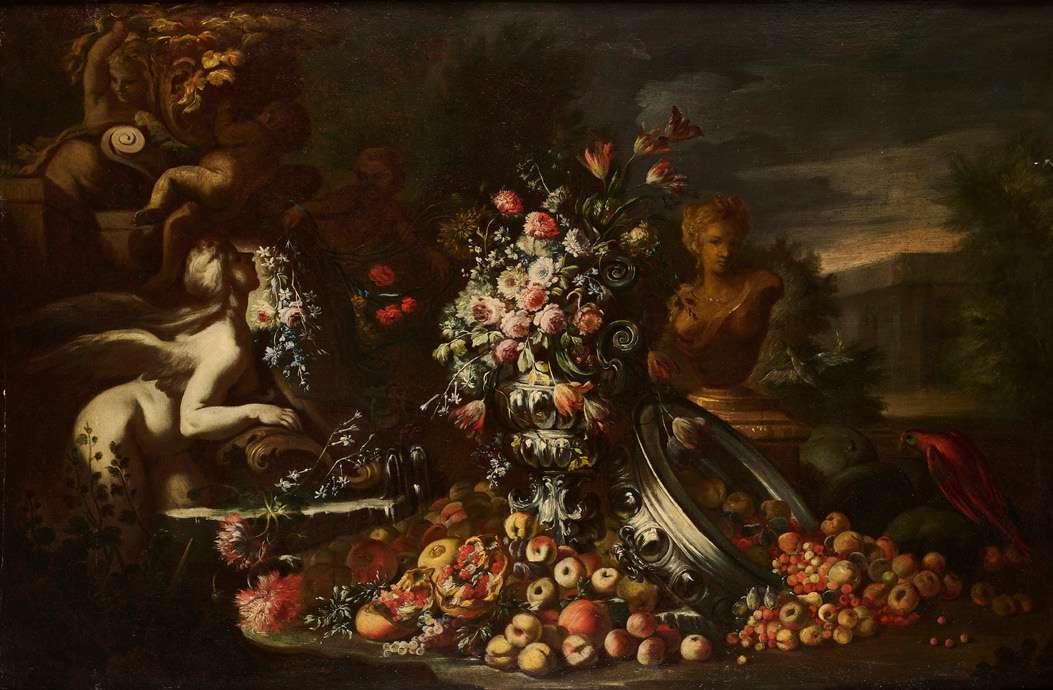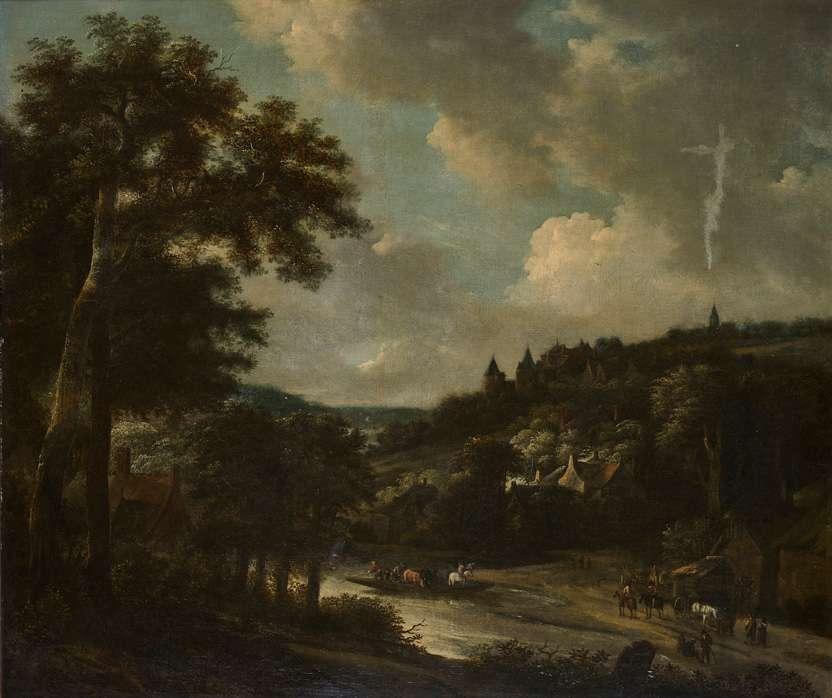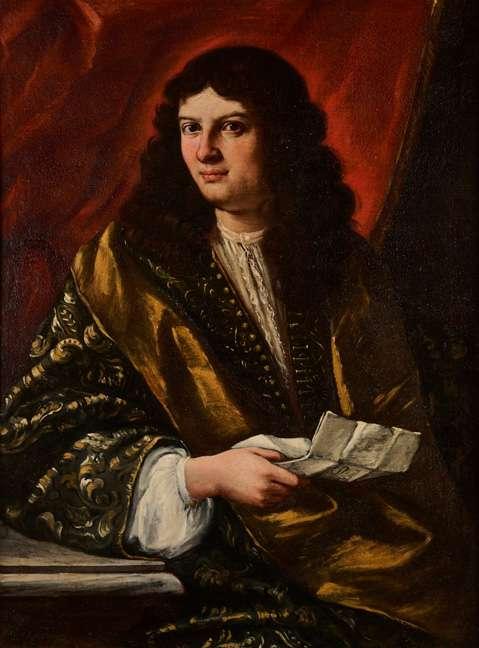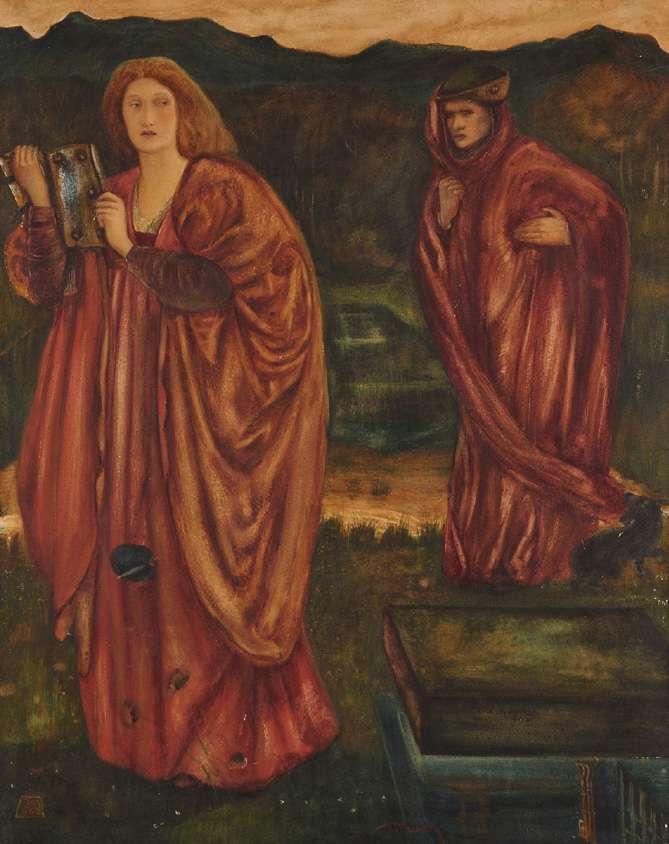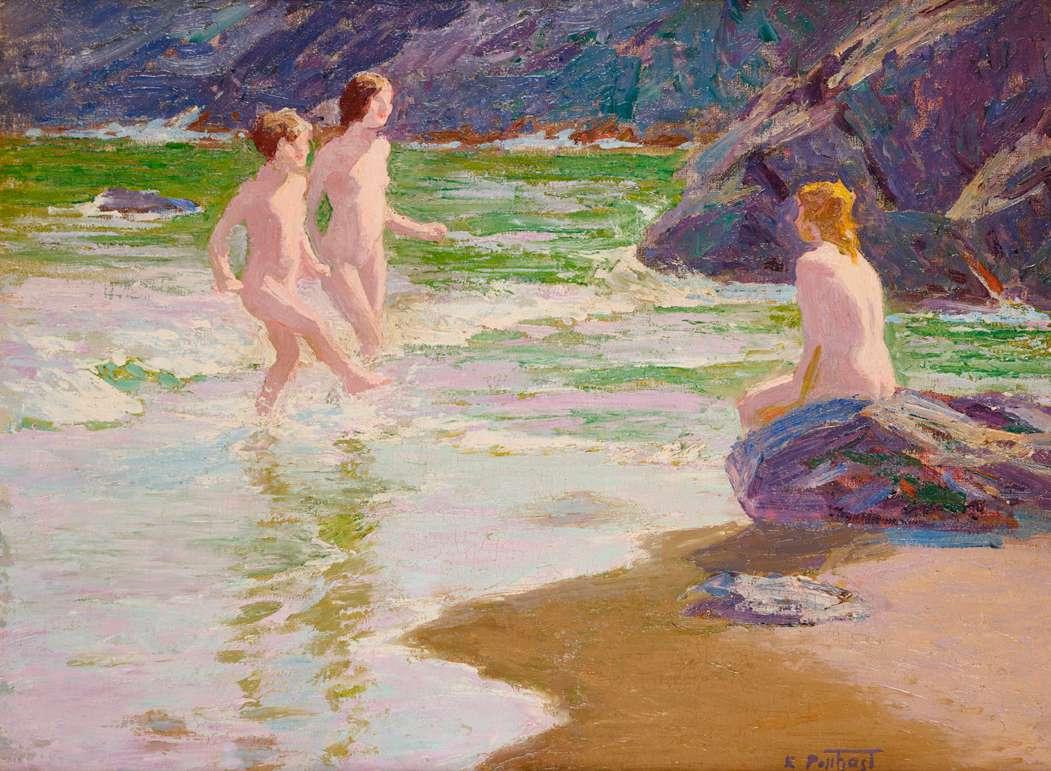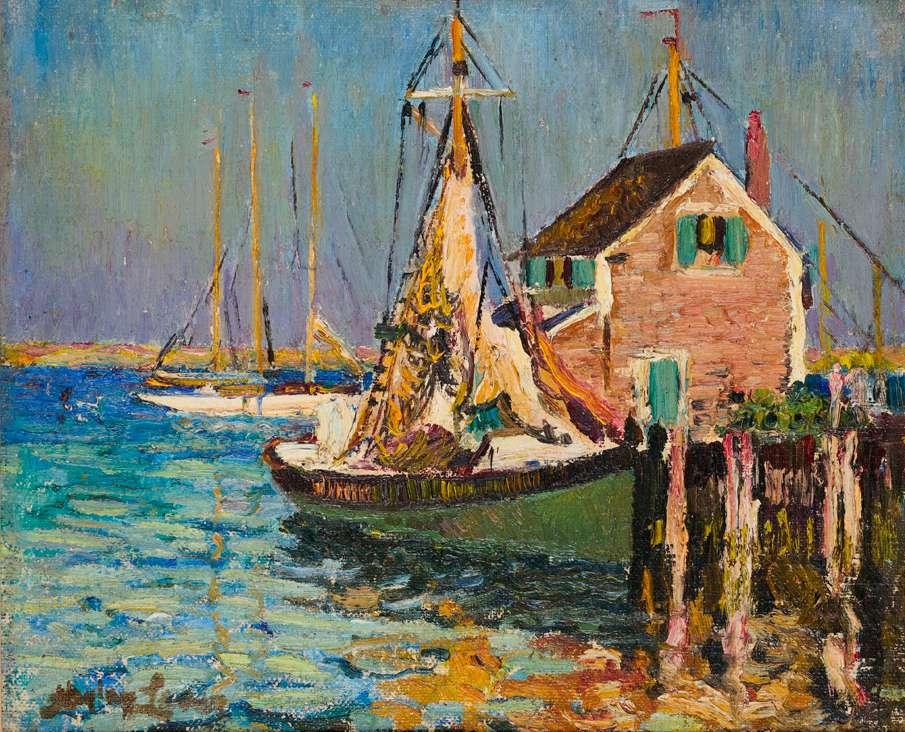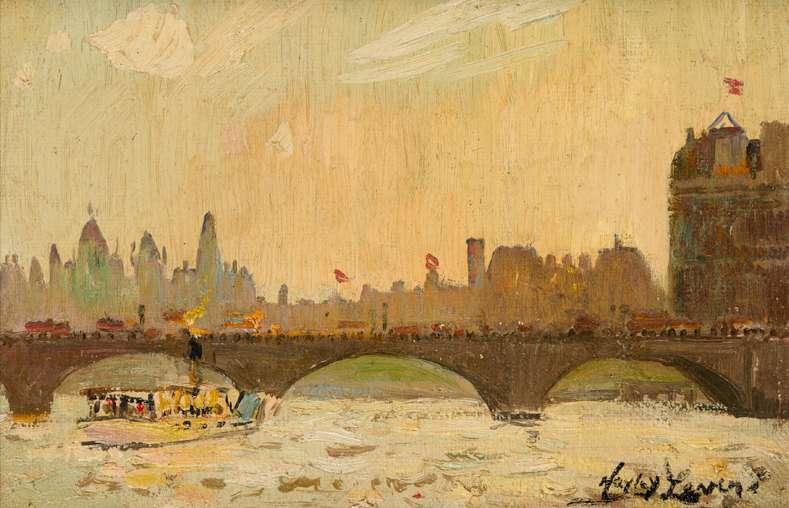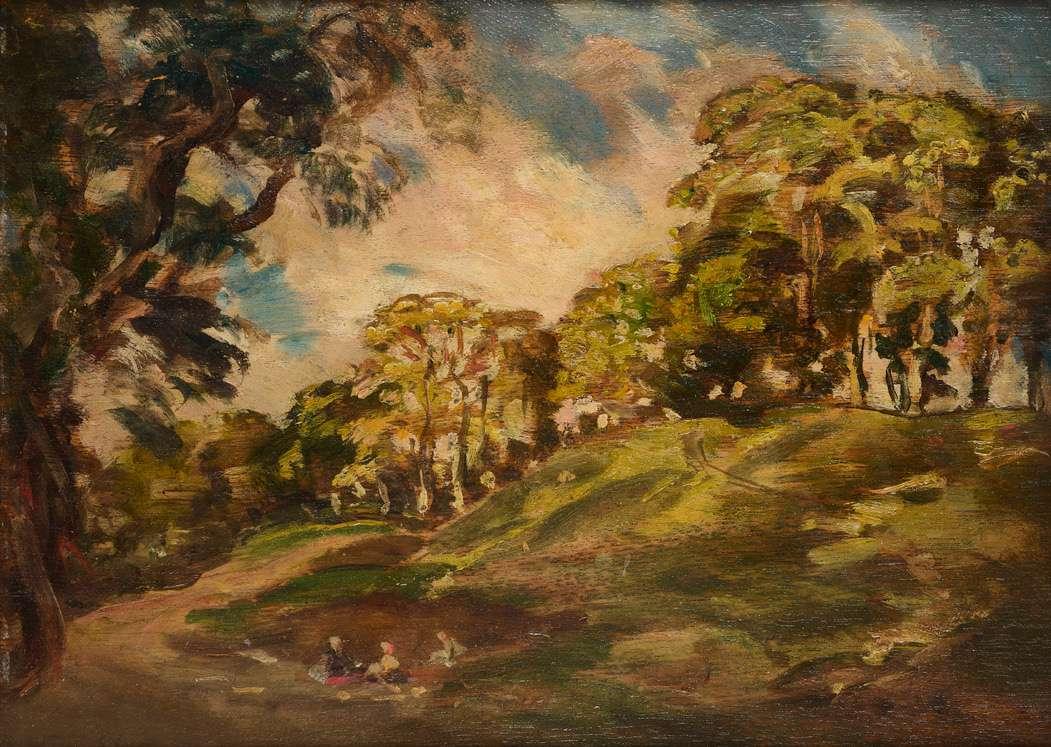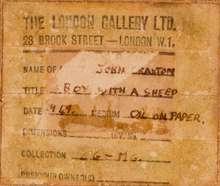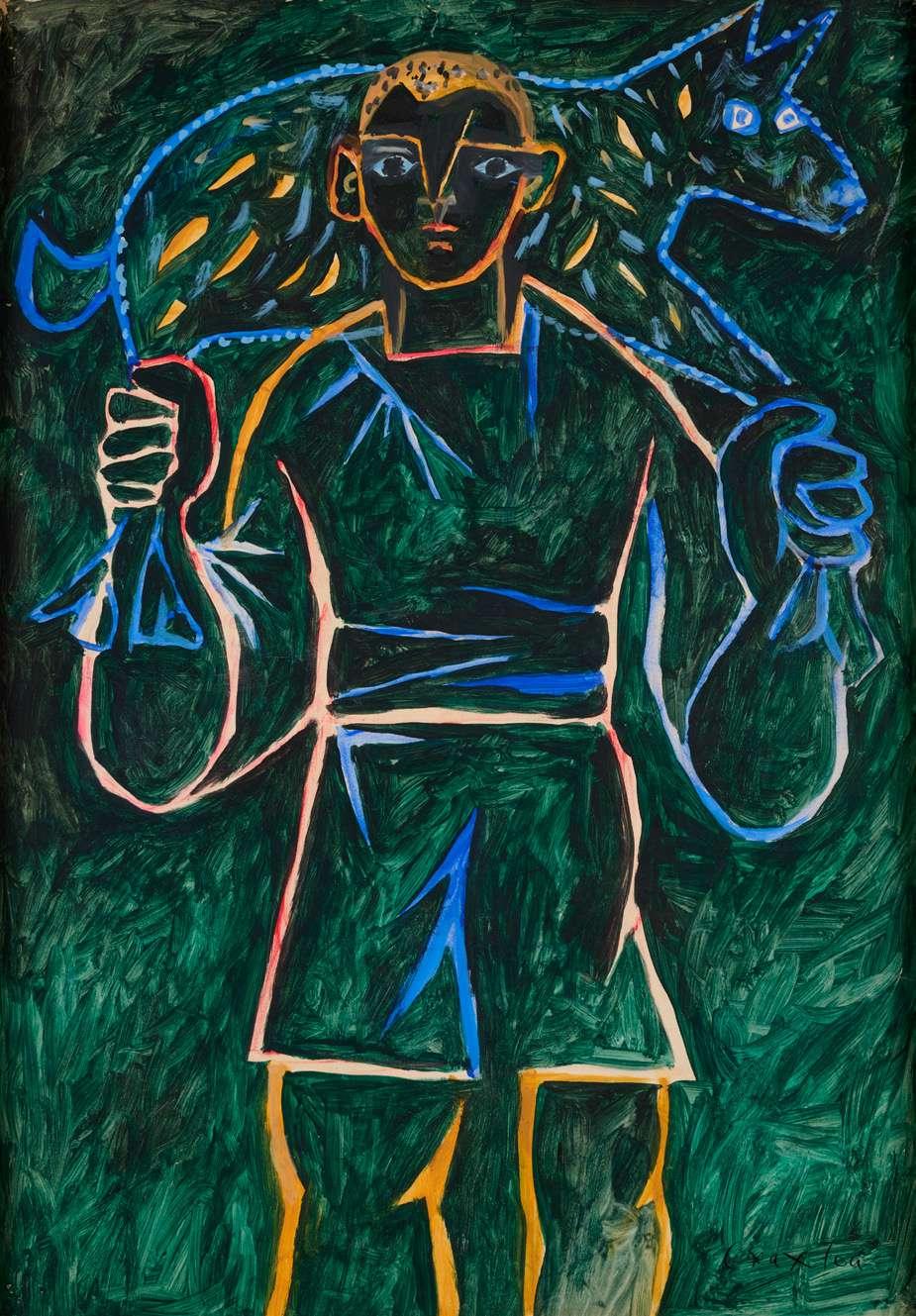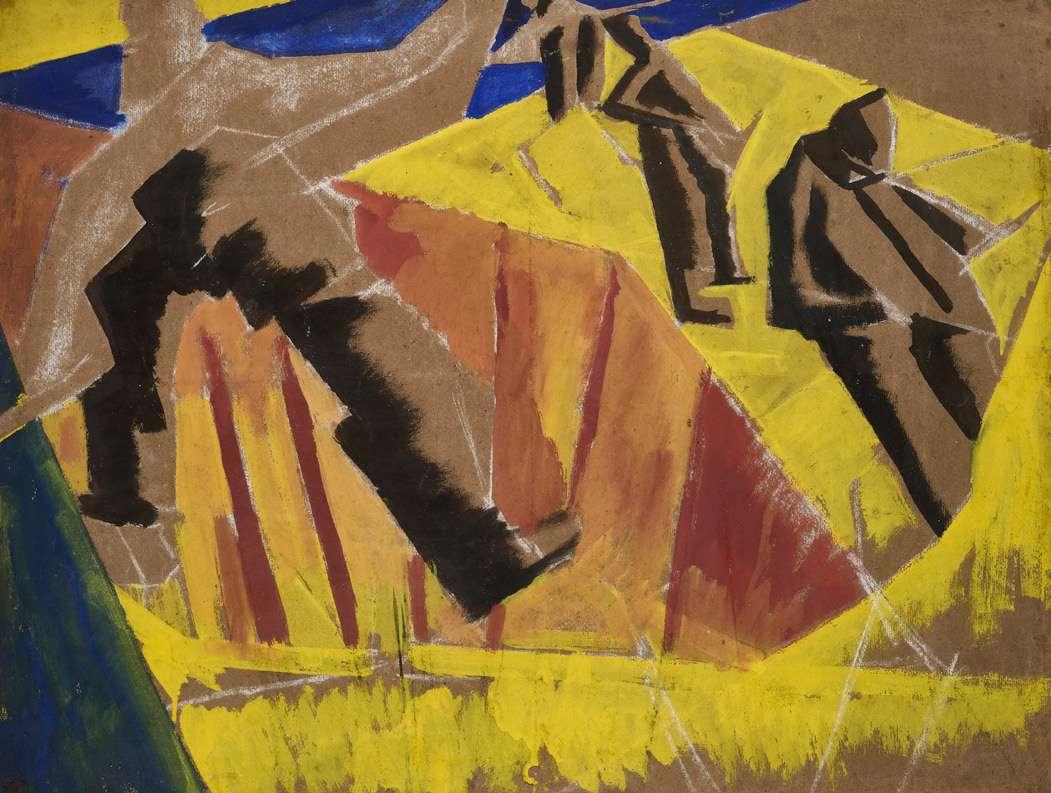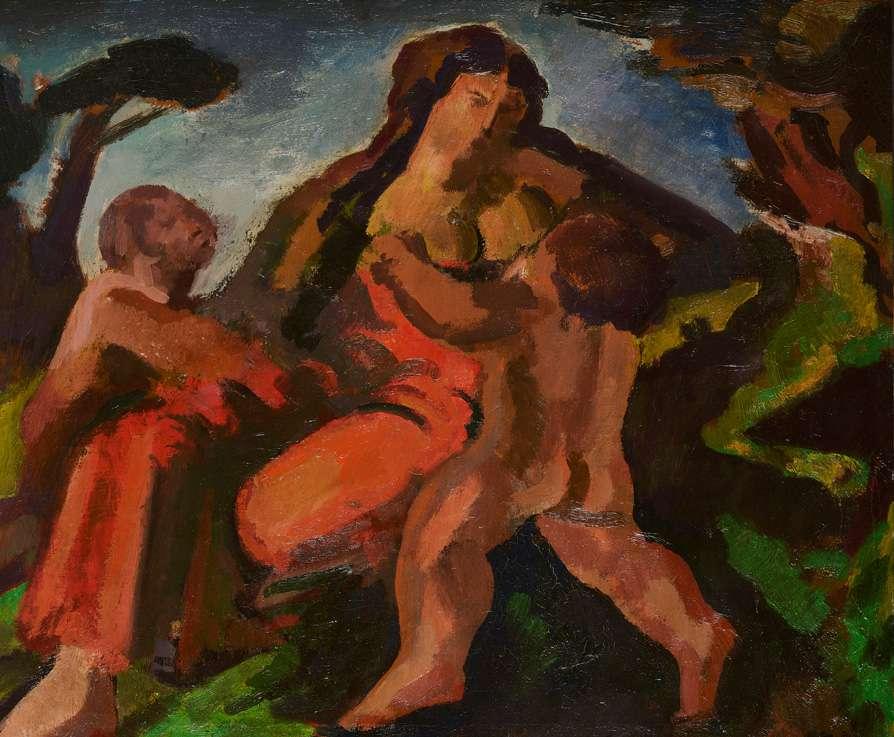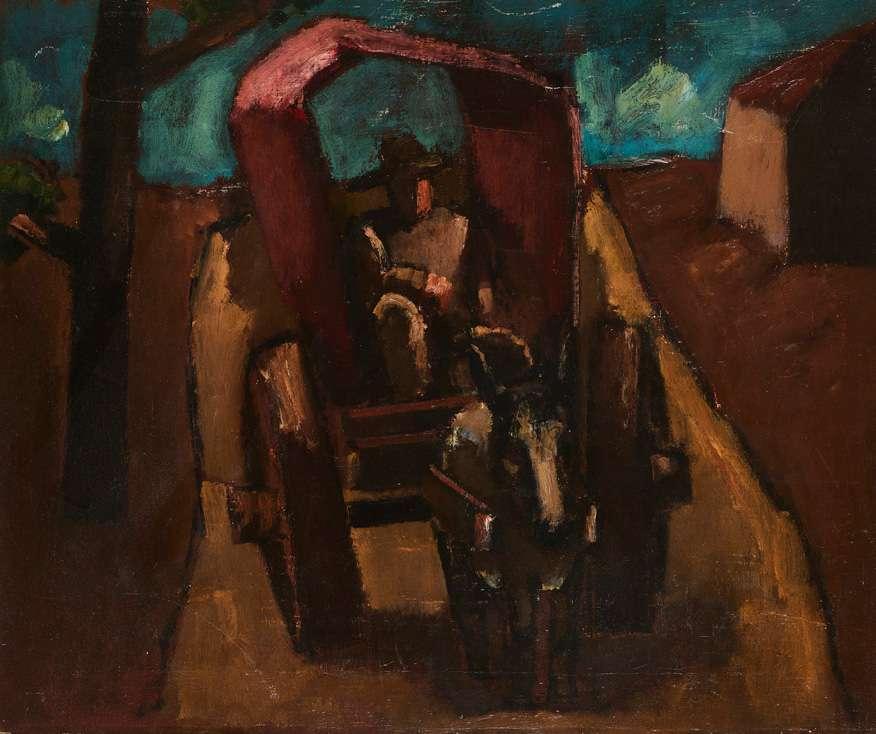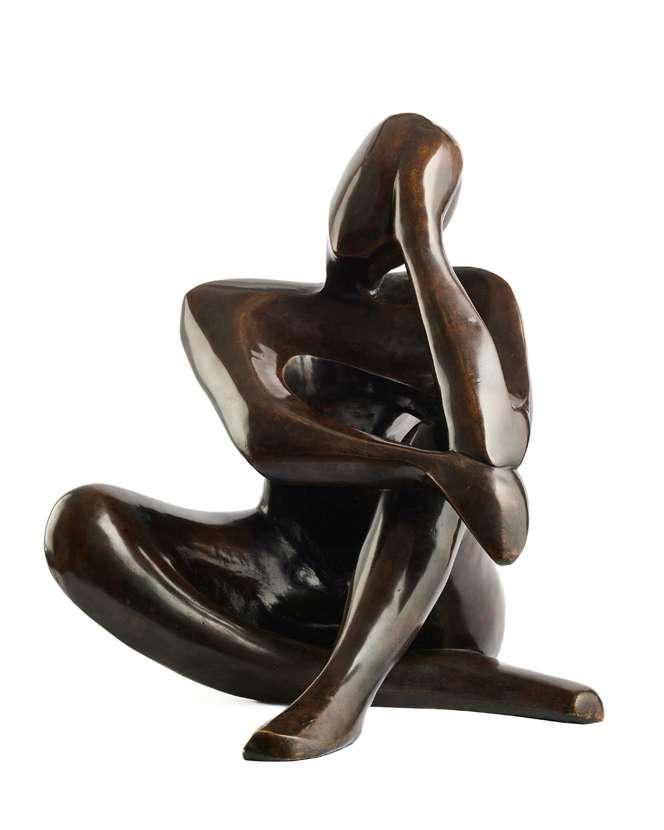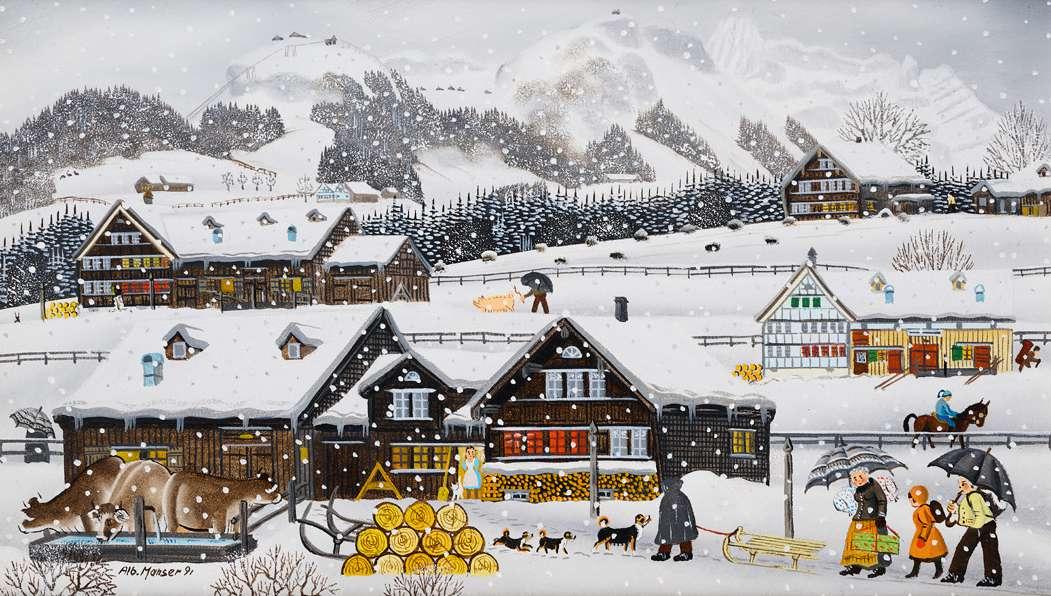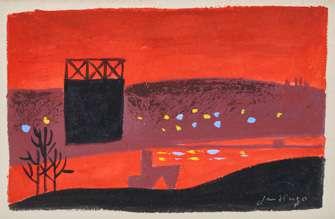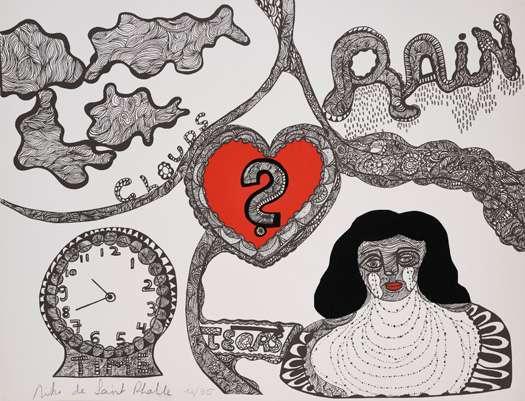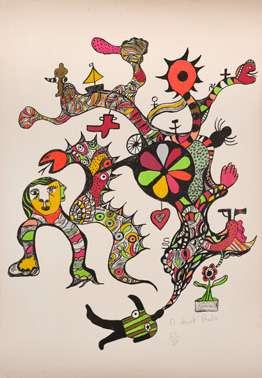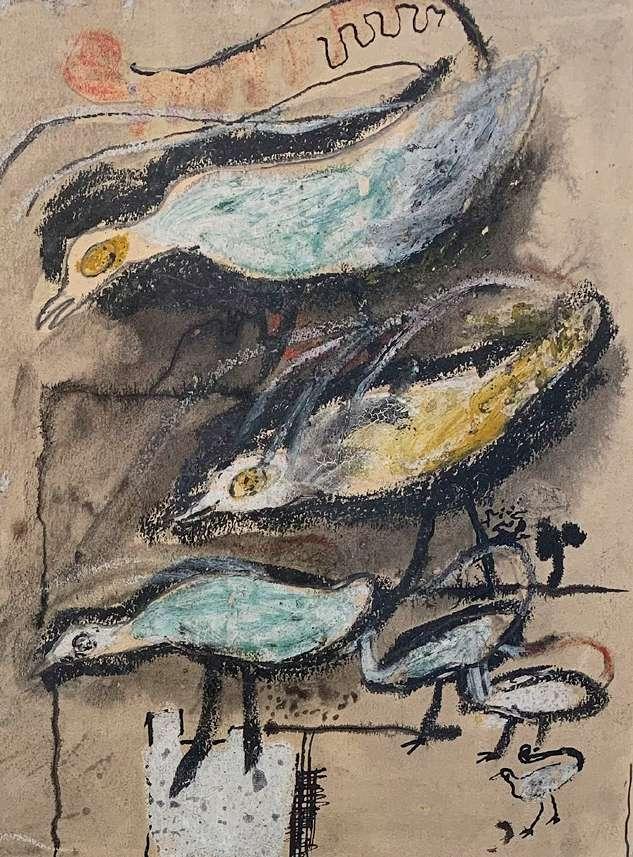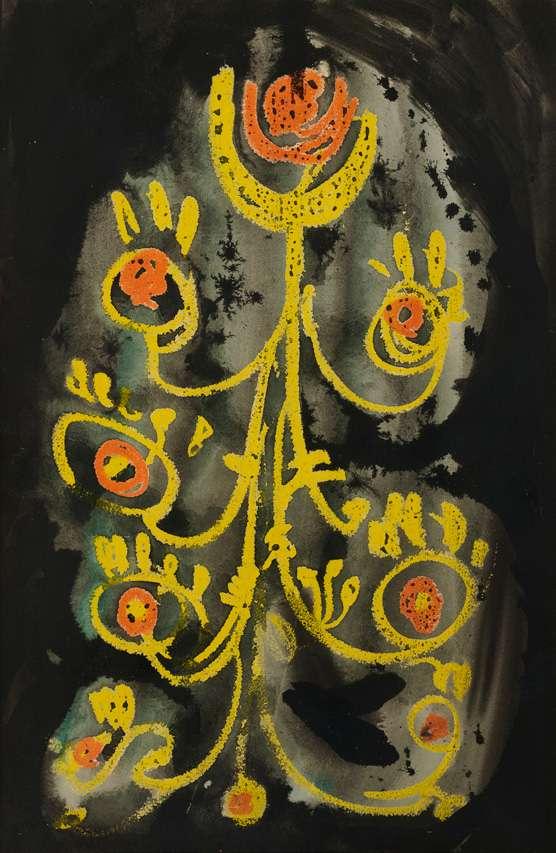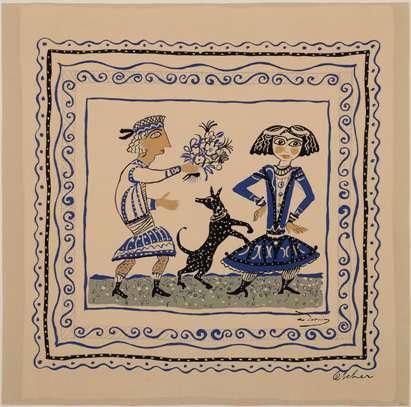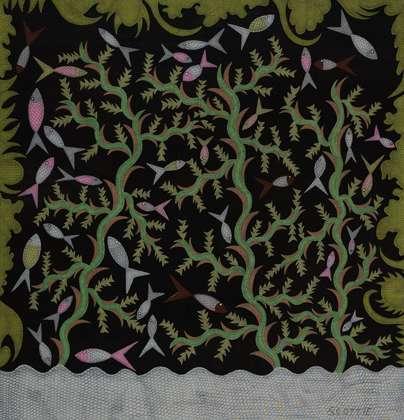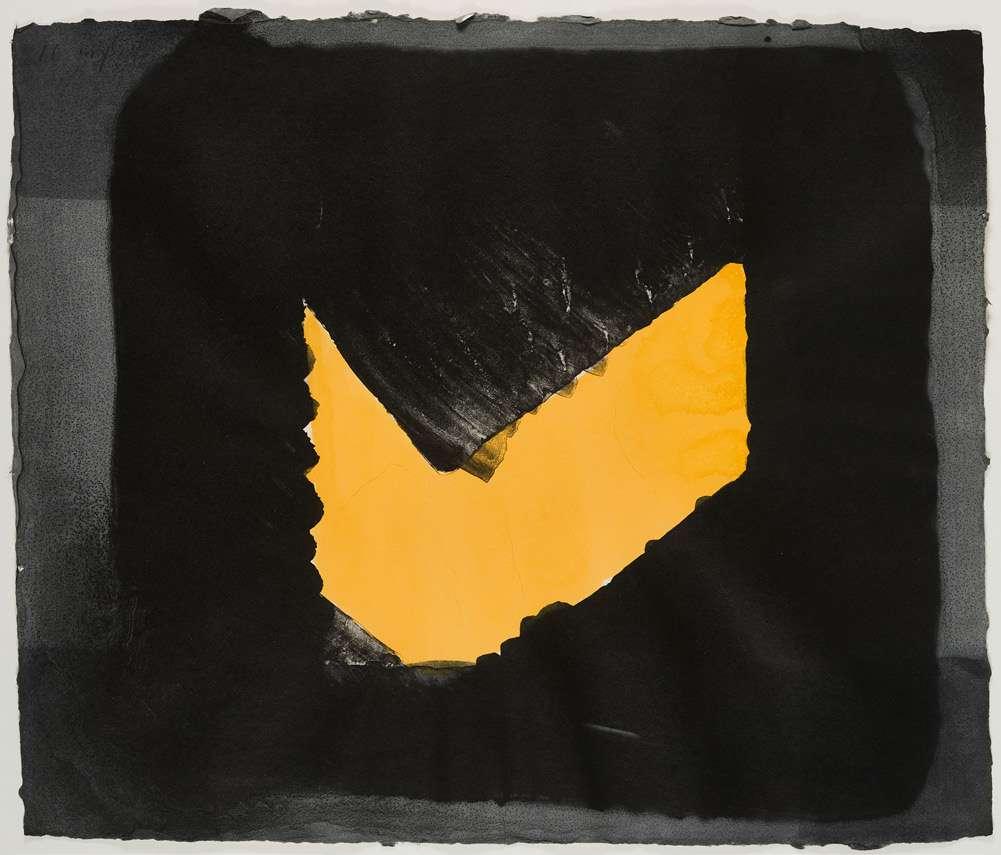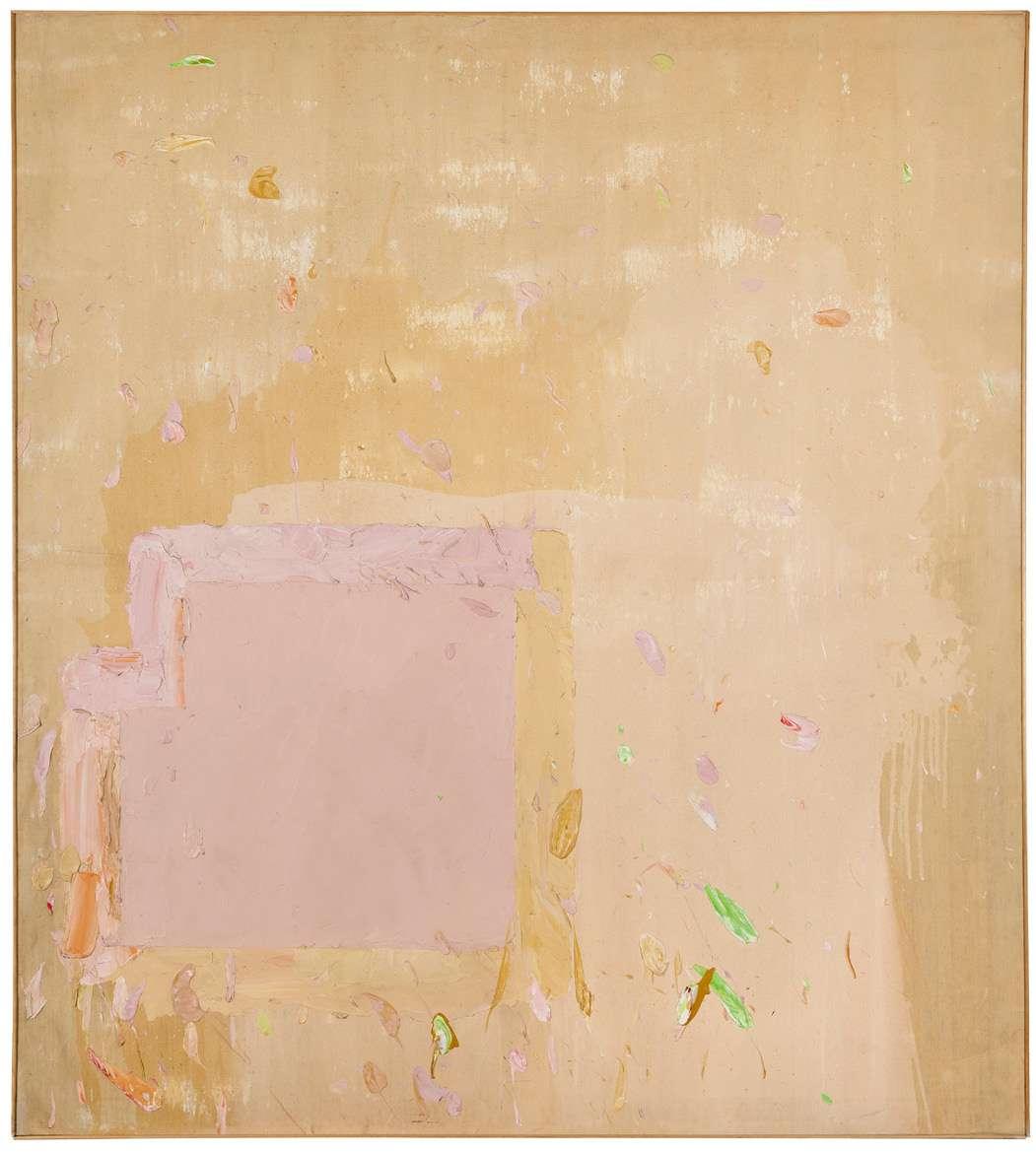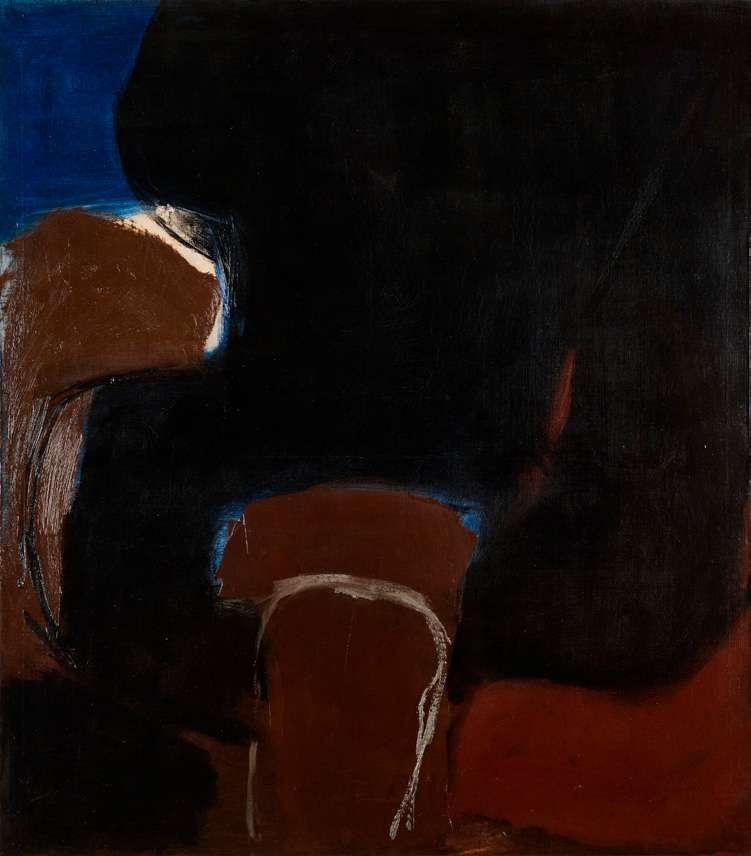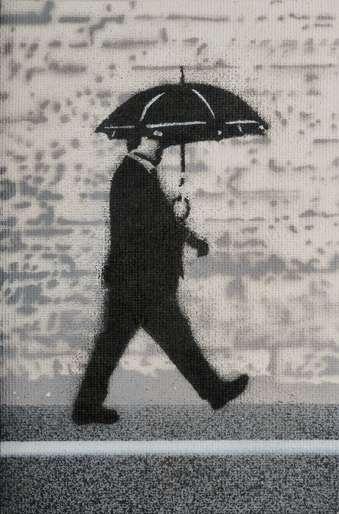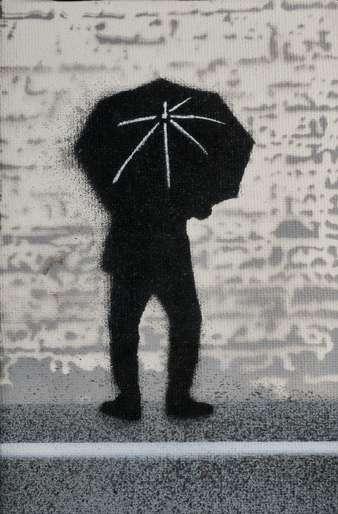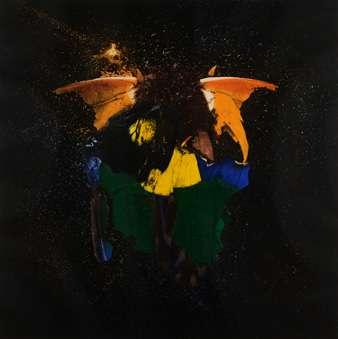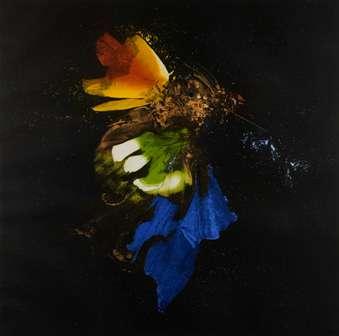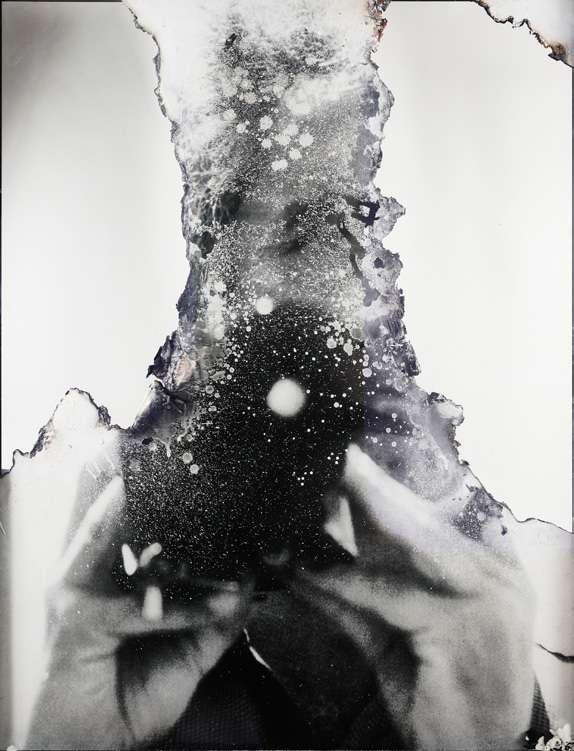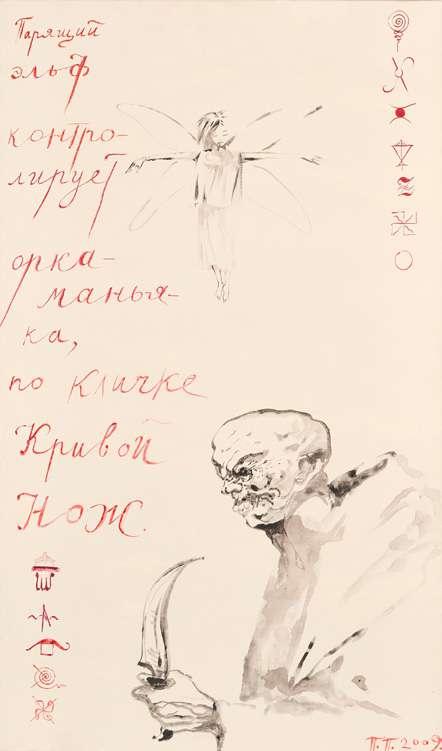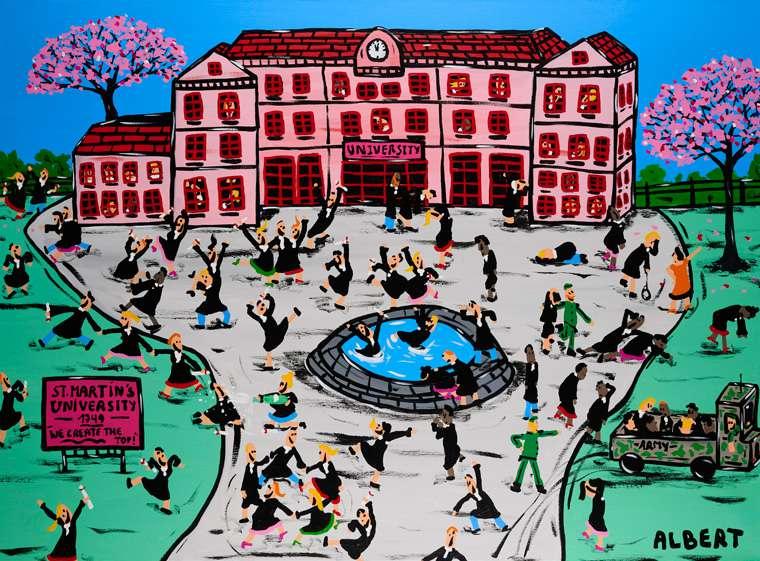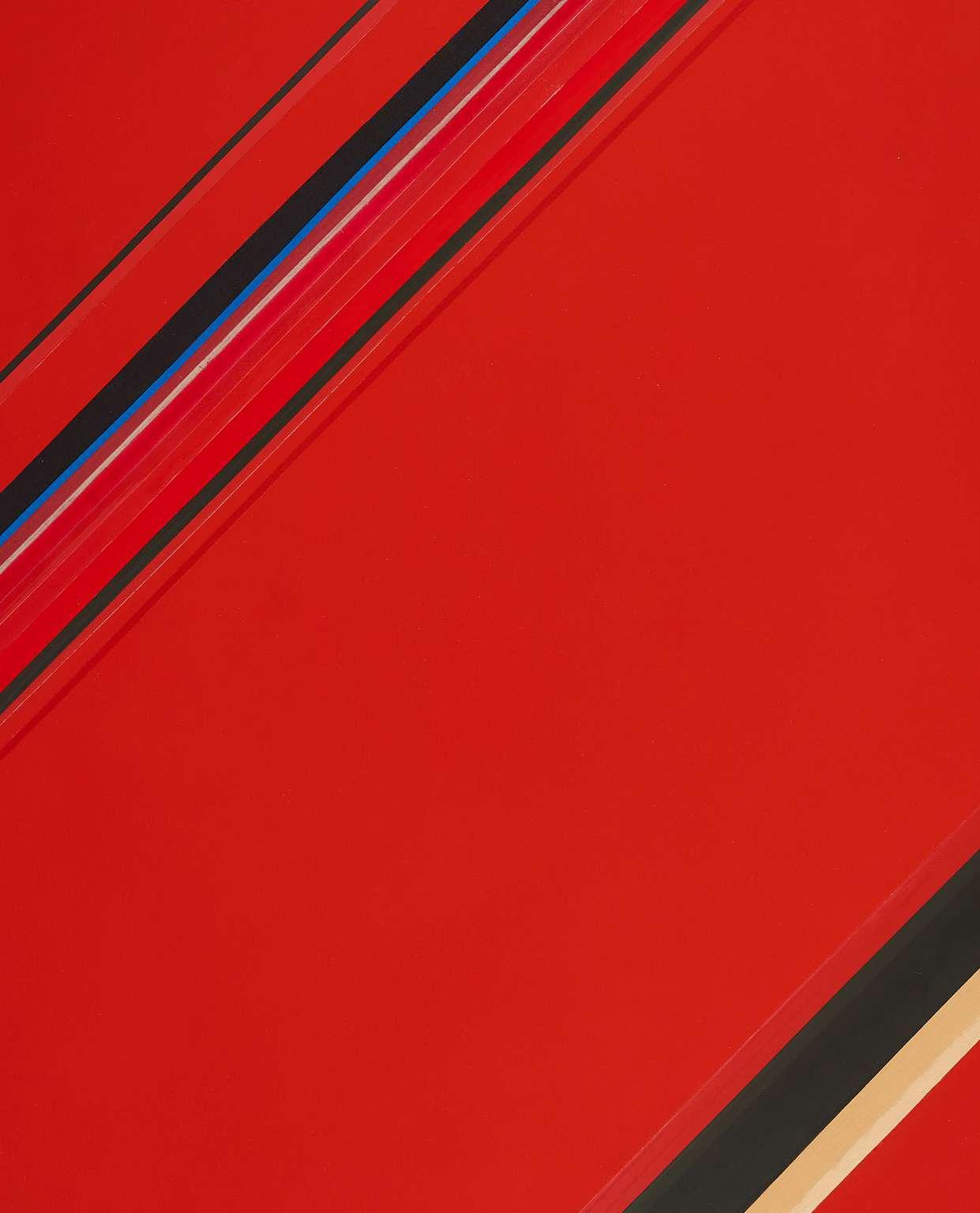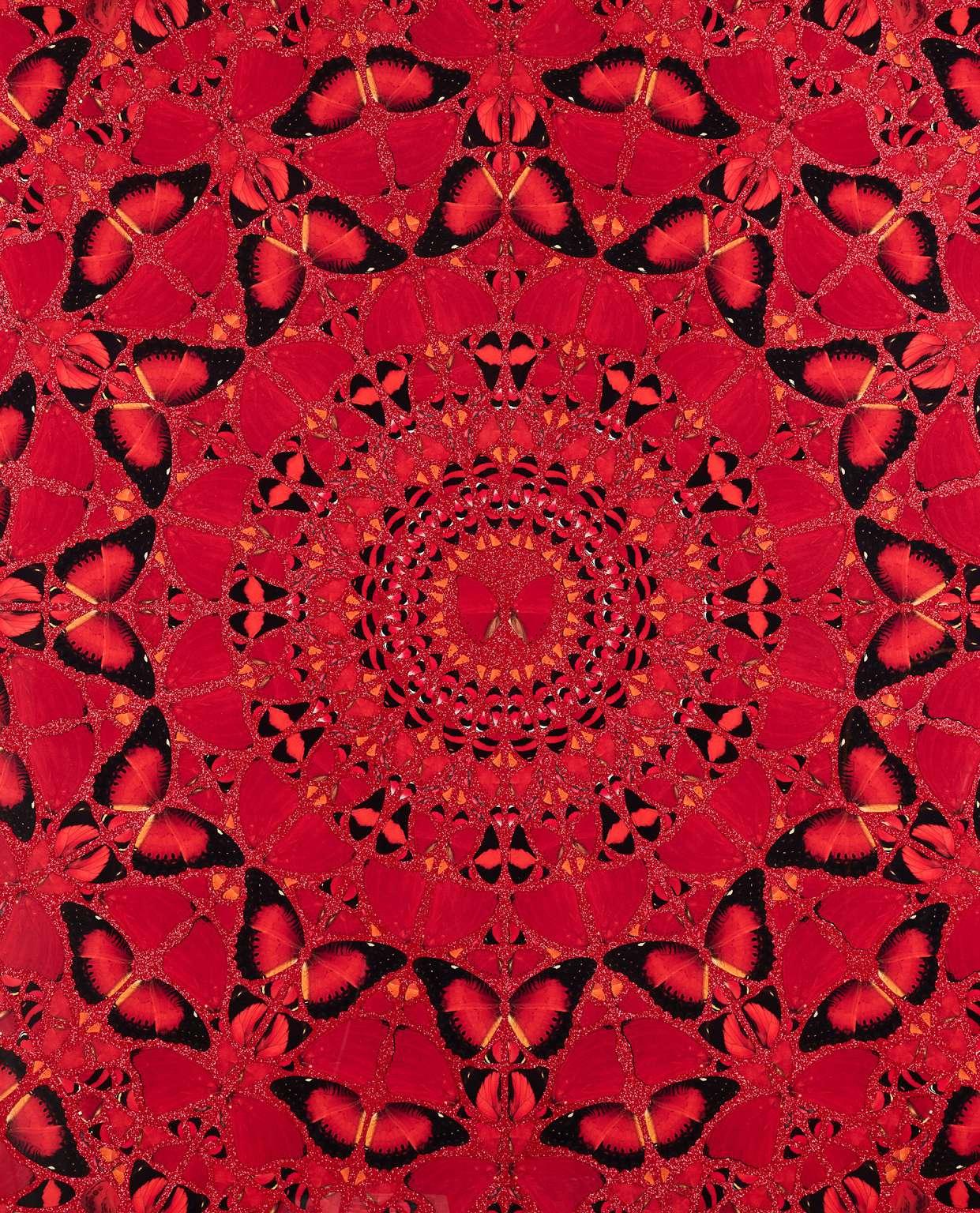PROPERTY FROM A PRIVATE COLLECTION, HAMPSTEAD
(LOTS 1-22)
INCLUDING FIFTEEN WORKS BY MORTIMER MENPES
The rich variety of Mortimer Menpes’ remarkable life could never be fully captured in just fifteen of his works. His interests ranged from sharp shooter (he shot for England) to market gardener, by way of artist, explorer, publisher, printer and self-confessed raconteur. But the following lots do give a lively sense of the extent of his travels, the range of his interests and his fascination with Japan in particular.
Menpes grew up in Port Adelaide, Southern Australia, where he showed early artistic potential. In 1875, aged twenty, he arrived in London with his parents, two of his sisters and Rosa Grosse to whom Menpes’ father was guardian, Rosa’s father having died the previous year. The sole beneficiary of her father’s estate, Rosa became engaged to Menpes on the voyage over, and the couple were married shortly after arriving in Britain. It was a fortuitous union, Menpes acknowledged, that gave him financial assurance and considerable artistic freedom.
Studying in London at The Government School of Design, South Kensington (now the Royal College of Art), Menpes learnt much from its director and principal Edward Poynter. But it was his meeting with James McNeill Whistler in 1880 that transformed his work and his social network. Together with Walter Sickert he worked as Whistler’s studio assistant, accompanied the American artist on sketching trips, including to Brittany, and shared a flat with him in Chelsea. Greatly influenced by Whistler’s aesthetic, in particular his debt to Japonisme, Menpes visited Japan in 1887. There he met the revered painter Kawanabe Kyōsai (1831-1889) and travelled the country meeting artists and sketching and painting. He returned to London with material for his first major exhibition: Paintings, Drawings and Etchings of Japan which opened at Dowdeswell & Dowdeswell’s, 160 New Bond Street in the spring of 1888.
Using small format panels that suited the intimacy of the subject matter, Menpes presented the works in stylised fluted frames that he had ordered from Japanese craftsmen (lots 1 & 2). He also hung the paintings close together in clusters on the gallery walls, reflecting the Japanese aesthetic for the careful placement of objects in space. The exhibition was a considerable success, with many leading collectors buying multiple works. However, Whistler was furious that Menpes had not acknowledged his influence, ceased communication, and bad-mouthed the younger artist in public.
Notwithstanding Whistler’s ire, a successful exhibition format was established which marked the beginning of Menpes’ collaboration with Dowdeswell & Dowdeswell’s over the following two decades and his rise to fame and even greater fortune. Virtually every other year Menpes travelled to distant parts returning with material to be shown. In 1890 he visited India, Burma and Kashmir, exhibiting the fruits of his labour in April and May 1891. Commenting on the success of the exhibition, the Pall Mall Gazette noted of the vernissage ‘Everyone was there, nothing was seen, and everything was sold’. Soon after he was in Venice, showing Fifty Pictures of Venice in June 1892 at
Mortimer Menpes, self-portrait, drypoint
the gallery. Paintings and sketches from his travels through France, Spain and Morocco when he also visited Cairo, were exhibited at Dowdeswell’s in June 1893. In 1895 he travelled to Mexico by Indian Pacific Cargo boat (lot 12), exhibiting Mexico by Mortimer Menpes in November and December. The following year he returned once more to Japan.
Financially flourishing, in 1898 Menpes engaged the architect A H Mackmurdo to construct a ‘Japanese’ house for he and his family at 25 Cadogan Gardens, Knightsbridge (figs. 1 & 2). Highly distinctive in its exterior design and with Japanese inspired and crafted interiors, the house became a magnet for hosting artistic soirees, social acceptance for Menpes which led to a succession of important portrait commissions. Sitters included Sarah Bernhardt, Sir Henry Irving and Arthur Conan Doyle.
Spreading his wings ever wider, in 1900 he was commissioned by the magazine Black and White Illustrated Weekly to accompany the City of London Imperial Volunteers as a war artist during the Boer War in South Africa. Two years later he returned to India to cover the Delhi Durbar - the coronation of King George VII, Emperor of India - for the Pall Mall Gazette, The Illustrated London News and Punch magazine. In London, in conjunction with the publishers A & C Black he pioneered a new form of illustrated travel book, printed in colour, and established a colour printing firm The Menpes Press. The project gave rise to a string of illustrated books on the countries regions and locales he had visited in the past, including India, Japan, China, Venice (lot 13), Brittany, The Thames and of course Japan (lot 11).
Commensurate with his foray into commercial printing, he also turned his attention back to etching, a skill that he had finessed when a student with Whistler, and in which there was wide resurgent interest (lot 15). Gradually Menpes’ etching replaced his interest in painting, and so his love of nature took the place of his enthusiasm for the city. In 1902 he and Rosa built Iris Court, in Pangbourne near Reading, a rather more conventional house than his Knightsbridge residence, and Menpes re-invented himself as a market gardener, setting up Menpes Fruit Farms close by in Purley-on-Thames. There he constructed forty large green houses in which to grow flowers, fruit and vegetables and eight cottages to accommodate the farm workers. Away from London and the limelight, he lived for the last three decades of his life in the relative calm of the shires.
Menpes first showed his work at the Royal Academy in 1880, he became a member of the Royal Society of Painter-Etchers and Engravers in 1881, Royal Society of British Artists in 1885, Royal Institute of Painters in Water in 1897 and Royal Institute of Oil Painters in 1899.
fig.2
fig.1
Property from a Private Collection, Hampstead
MORTIMER MENPES (AUSTRALIAN/BRITISH 1855-1938)
ON THE MARGE OF THE SUNSET, BENARES
signed Mortimer Menpes lower left; inscribed Benares beneath a label on the reverse
oil on panel, in the artist’s original designed fluted panel frame with offset window 10 x 16.5cm; 4 x 6 1/2in
34.5 x 28.5cm; 13 1/2 x 11 1/4in (framed)
London, Dowdeswell & Dowdeswell’s Galleries, Paintings, Drawings, Etchings and Diamond Points on Ivory of India, Burma and Cashmere, 1891, no. 102
The Cotman Gallery, Birmingham
The Graves Gallery, Birmingham Adelaide, Art Gallery of South Australia, The World of Mortimer Menpes, Painter, Etcher, Raconteur, 2014, n.n. (illustrated in colour in the catalogue, pp. 59 & 195)
Menpes first visited India, Kashmir and Burma (now Mayanmar) in 1890, exhibiting the fruits of his travels in the spring of the following year in Paintings, drawings, etchings and diamond points on ivory, of India, Burma and Cashmere at Dowdeswell & Dowdeswell’s gallery at 160 New Bond Street. In 1902 he returned again to India to cover the Delhi Durbar (see introduction). After completing his assignment, he travelled extensively in northern India, once again visiting Kashmir. His exhibition Paintings of India by Mortimer Menpes at Dowdeswell & Dowdeswell in 1905 coincided with the publication of Menpes in India which featured seventy five colour plates by the artist and text by Flora Annie Steel, an author noted for her writing on the Indian sub-continent.
The frame of this and the following lot reflects Menpes’ fascination with Japonisme, the formative years he spent working with Whistler, and the influence in particular of his trip to Japan in 1887. Impressed with the high quality of Japanese craftsmanship on his travels through the country, he ordered two hundred frames to be sent back to England. On their arrival in London they were gilded by Frederick Henry Grau in his Fulham workshop (Grau’s label is stuck to the reverse of the present lot). For a full discussion of Menpes’ innovative frame designs visitwww.theframeblog.com.
£3,500-5,500
Property from a Private Collection, Hampstead 2
MORTIMER MENPES (AUSTRALIAN/BRITISH 1855-1938) ON THE GANGES
signed Mortimer Menpes lower left; titled On The Ganges on the reverse oil on panel, in the artist’s original designed fluted panel frame with offset window
10 x 16.5cm; 4 x 6 1/2in
34.5 x 28.5cm; 13 1/2 x 11 1/4in (framed)
Provenance
The Cotman Gallery, Birmingham
The Graves Gallery, Birmingham
Exhibited
London, Dowdeswell & Dowdeswell’s Galleries, Paintings, Drawings, Etchings and Diamond Points on Ivory of India, Burma and Cashmere, 1891
Adelaide, Art Gallery of South Australia, The World of Mortimer Menpes, Painter, Etcher, Raconteur, 2014, n.n (illustrated in colour in the catalogue, pp. 195)
see note to previous lot
£3,000-5,000
lot 2 (in its original Japanese frame)
lot 1 (reverse of the frame)
lot 1 (in its original Japanese frame)
1 (actual size)
2 (actual size)
Property from a Private Collection, Hampstead 3
MORTIMER MENPES (AUSTRALIAN/BRITISH 1855-1938)
FAMILY IN KASHMIR
signed Mortimer Menpes lower right oil on panel
21.5 x 26.5cm; 8 1/2 x 10 1/2in
36 x 41.5cm; 14 1/4 x 16 1/4in (framed)
Provenance
James Stark, Norwich
Sale, Christie’s, London, 22 November 1918, lot 137
Sale, Phillips, Oxford, 4 June 1987, lot 63
Purchased at the above sale by the family of the present owner
Exhibited
London, Dowdeswell & Dowdeswell’s Galleries, Paintings, Drawings, Etchings and Diamond
Points on Ivory of India, Burma and Cashmere, 1891
Adelaide, Art Gallery of South Australia, The World of Mortimer Menpes, Painter, Etcher, Raconteur, 2014, n.n. (illustrated in colour in the catalogue, pp. 81 & 195)
see note to lot 1
£5,000-7,000
lot 5 (sketch on the reverse)
Property from a Private Collection, Hampstead 4
MORTIMER MENPES
(AUSTRALIAN/BRITISH 1855-1938)
A ROOT SELLER
signed Mortimer Menpes on the reverse oil on panel
16 x 10cm; 6 1/4 x 4in
27.5 x 21.5cm; 10 3/4 x 8 1/2in (framed)
Exhibited
5 (actual size)
Property from a Private Collection, Hampstead 5
MORTIMER MENPES (AUSTRALIAN/BRITISH 1855-1938)
YOUNG BOY, JAPAN
signed Mortimer Menpes lower left oil on board
15.5 x 11cm; 6 x 4 1/4in
27.5 x 23cm; 10 3/4 x 9in (framed)
Exhibited
London, Dowdeswell & Dowdeswell’s Galleries, Paintings of France, Spain and Morocco, 1893, no. 31
Adelaide, Art Gallery of South Australia, The World of Mortimer Menpes, Painter, Etcher, Raconteur, 2014, n.n (illustrated in colour in the catalogue, pp. 85 & 196)
£1,200-1,800
London, Dowdeswell & Dowdeswell’s Galleries, Paintings and Drawings of Japan, 1897
Adelaide, Art Gallery of South Australia, The World of Mortimer Menpes, Painter, Etcher, Raconteur, 2014, n.n (illustrated in colour in the catalogue, pp. 91 & 197)
There is a sketch in pen and ink of women seated in an interior on the reverse.
£1,500-2,500
6
Property from a Private Collection, Hampstead 7
MORTIMER
MENPES (AUSTRALIAN/BRITISH 1855-1938)
MOTHER WITH HER BABY ON HER BACK, JAPAN
signed Mortimer Menpes lower left oil on board
11 x 15cm; 4 1/4 x 6in
15 x 19.5cm; 6 x 7 3/4in (framed)
Exhibited
Property from a Private Collection, Hampstead 6
MORTIMER MENPES
(AUSTRALIAN/BRITISH 1855-1938)
GEISHA PLAYING THE SHAMISEN signed Mortimer Menpes lower right oil on board
15.5 x 11cm; 6 x 4 1/4in
27.5 x 23cm; 11 x 9in (framed)
Exhibited
London, Dowdeswell & Dowdeswell’s Galleries, Paintings and Drawings of Japan, 1897
Adelaide, Art Gallery of South Australia, The World of Mortimer Menpes, Painter, Etcher, Raconteur, 2014, n.n (illustrated in colour in the catalogue, p. 197)
Menpes celebrates the geisha at length in his book on Japan, he notes how: The raison d’être of the geisha is to be decorative. She delights in her own delightsomeness; she wants frankly to be as charming as nature and art will allow; she wants to be beautiful; and she honestly and assuredly wants me and you and the stranger artists to think her beautiful… It is the artist’s ambition that she should be a picture, perfect in every detail, and the geisha is always a picture, beautiful beyond description’ (Japan, A Record in Colour by Mortimer Menpes, Transcribed by Dorothy Menpes, London, 1901, pp. 126 & 133). The instrument the geisha is playing in this dramatically lit painting is a shamisen, a threestringed instrument played with a plectrum.
£2,500-3,500
London, Dowdeswell & Dowdeswell’s Galleries, Paintings and Drawings of Japan, 1897 Adelaide, Art Gallery of South Australia, The World of Mortimer Menpes, Painter, Etcher, Raconteur, 2014, n.n (illustrated in colour in the catalogue, pp. 95 & 197)
Menpes recorded the Japanese practice of young children being carried on the backs of their mothers or a sibling in a series of works, three of which appear in his illustrated book on Japan with text by his daughter Dorothy. See Japan, A Record in Colour by Mortimer Menpes, Transcribed by Dorothy Menpes, London, 1901, p. 54, no. 28 (Bearing a Burden), p. 84, no. 33 (Heavy Laden) and p. 138, no. 49 (Baby and Baby).
£1,500-2,500
Property from a Private Collection, Hampstead 8
MORTIMER MENPES
(AUSTRALIAN/BRITISH 1855-1938)
ILLUSTRATED LETTER ADDRESSED TO ‘DEAR GREAT ONE’ signed Mortimer Menpes lower right pen and ink on the artist’s monogrammed writing paper
22.5 x 18cm; 8 3/4 x 7in
40.5 x 35cm; 16 x 13 3/4in (framed)
Exhibited Adelaide, Art Gallery of South Australia, The World of Mortimer Menpes, Painter, Etcher, Raconteur, 2014, n.n (illustrated in colour in the catalogue, p. 221)
Sent from the Shirley Hotel in Weymouth, Menpes writes: Dear Great One / Right about the frames and many thanks - I do hope he will be at the gallery on the 25th. Please tell Arthur his shorthand notes are quite good I only finished reading them yesterday. You must be prepared for emptiness with the new Japanese work. Think of my painting watercolours 2 feet x 3 feet. Don’t please send on any more letters here as I might leave at any moment. Yours truly / Mortimer Menpes
The salutation - ‘Dear Great One’, Menpes’ reference to his ‘new Japanese work’, together with the two quick head studies of a Japanese man and boy in the left margin indicate that Menpes penned this letter after returning from his second visit to Japan in 1896.
£200-300
7 (actual size)
9 (actual size)
Property from a Private Collection, Hampstead
9
MORTIMER MENPES (AUSTRALIAN/BRITISH 1855-1938)
THE STENCIL-MAKER
signed Mortimer Menpes lower right oil on board
11 x 15.5cm; 4 1/4 x 6in
15 x 19.5cm; 6 x 7 3/4in (framed)
Exhibited
London, Dowdeswell & Dowdeswell’s Galleries, Paintings and Drawings of Japan, 1897 Adelaide, Art Gallery of South Australia, The World of Mortimer Menpes, Painter, Etcher, Raconteur, 2014, n.n (illustrated in colour in the catalogue, p. 197)
Painted on one of Menpes’ two trips to Japan in 1887 and 1896, the figure of a stencil maker in the present work appears in the forground of the watercolour Stencil-makers illustrated in Japan, A Record in Colour by Mortimer Menpes, Transcribed by Dorothy Menpes, London, 1901, p. 174, no. 66. The book features seventy-five colour illustrations by Menpes that capture views of the Japan and different aspects of Japanese life and culture combined with written impressions gathered together by Menpes’ daughter Dorothy (1883-1973).
Describing how he became aware of the art of stencil making in Japan Menpes recalled: ‘I ordered several pieces of cotton crêpe of a certain design that I had drawn myself, and it was during the execution of this commission that I was brought into touch with the stencilworkers and dyers of the country. Stencil-cutting is one of the most beautiful arts imaginable. To see the stencil-workers cutting fantastic designs from the hard polished cardboard beneath their instruments - so delicate that it is like the tracery of a spider’s web in its tenuity - is a sight that one never forgets. Some of the designs are so cobweb-like that single human hairs are used in parts to keep them from breaking to pieces.’ (Japan, A Record in Colour, p. 176).
£1,500-2,500
Property from a Private Collection, Hampstead 10
MORTIMER MENPES
(AUSTRALIAN/BRITISH 1855-1938)
UMBRELLAS AND COMMERCE, JAPAN gouache on paper mounted on an ornamented handscreen fan
12 x 16.5cm; 4 3/4 x 6 1/2in
18 x 22.5cm; 7 x 8 3/4in (fan)
The present work relates to Menpes’ illustration of the same subject reproduced in Japan, A Record in Colour by Mortimer Menpes, Transcribed by Dorothy Menpes, London, 1901, p. 190, no. 72.
see note to previous lot
£1,000-1,500
Property from a Private Collection, Hampstead 11
MORTIMER MENPES (AUSTRALIAN/BRITISH 1855-1938)
ON THE GREAT CANAL, OSAKA
signed Mortimer Menpes lower left watercolour, gouache and pencil on paper
32 x 40cm; 12 1/2 x 15 3/4in
52 x 60cm; 20 1/2 x 23 1/2in (framed)
Executed circa 1900.
The present work is Menpes’ original gouache for the illustration of On the Great Canal, Osaka in Japan, A Record in Colour by Mortimer Menpes, Transcribed by Dorothy Menpes, London, 1901, p. 46, no. 21
see note to lot 9
£3,000-5,000
Property from a Private Collection, Hampstead 12
MORTIMER MENPES (AUSTRALIAN/BRITISH 1855-1938) NIGHT SCENE AT PUEBLA
signed Mortimer Menpes lower right; signed Menpes on the reverse brush and pen and indian ink heightened with white on paper laid down on card 66 x 50cm; 26 x 19 3/4in 84 x 68cm; 33 x 26 3/4in (framed)
Executed circa 1895 when Menpes travelled to Mexico. £800-1,200
Property from a Private Collection, Hampstead 13
MORTIMER MENPES (AUSTRALIAN/BRITISH 1855-1938)
OSPEDALE CIVILE, VENICE
signed Mortimer Menpes lower left gouache and pencil on card
28 x 38.5cm; 11 x 15 1/4in
37 x 47.5cm; 14 1/2 x 18 3/4in (framed)
The present work is Menpes’ original gouache for the illustration of the Ospedale Civile, Venice in Venice by Mortimer Menpes with text by Dorothy Menpes, London, 1904, p. 76, no. 32. The publication features seventy-five colour illustrations by Menpes that capture views of the city and different aspects of Venetian life combined with written impressions penned by Menpes’ daughter Dorothy (1883-1973).
£1,500-2,500
Property from a Private Collection, Hampstead 14
MORTIMER MENPES
(AUSTRALIAN/BRITISH 1855-1938)
STUDY OF A GIRL, PROBABLY THE ARTIST’S DAUGHTER
signed Mortimer Menpes lower right watercolour on board
31 x 40cm; 12 1/4 x 15 3/4in
48 x 57cm; 19 x 22 1/2in (framed)
Menpes had two daughters, Rose Maud and Dorothy Whistler. Dorothy collaborated with Menpes on the texts for at least seven of the series of travel books her father illustrated, published by A & C Black between 1900 and 1912, including Japan (lots 6-11) Venice (lot 13), Brittany, Paris, The Durbar, War Impressions and World’s Children. Dorothy’s middle name, Whistler, was named after the artist James McNeill Whistler who was her godfather.
£1,000-1,500
£200-300 14
Property from a Private Collection, Hampstead 15
MORTIMER MENPES
(AUSTRALIAN/BRITISH 1855-1938)
INTERIOR OF THE CHURCH OF SAINT-MACLOU, ROUEN, FACING EAST
signed and dated Mortimer Menpes imp in pencil lower right margin etching on paper
31 x 16cm; 12 1/4 x 6 1/4in unframed
Printed by the artist in an edition of 50.
As well as the interior of the church of Saint Maclou in Rouen, Menpes also etched the main entrance of the cathedral and painted and sketched the city’s streets. His interest in Rouen as a subject matter may well have been stirred by Monet’s painting of Rouen and its cathedral in 1893-94. It was also a city favoured by Whistler, in whose company Menpes would have visited in the 1880s.
Property from a Private Collection, Hampstead
16
A PITILESS WIND
signed E.F BREWTNALL lower left
oil on canvas
110 x 80.5cm; 43 1/4 x 31 3/4in
133 x 103cm; 52 1/4 x 40 1/2in (framed)
Provenance
Brighouse Public Library and Art Gallery, Calderdale
£2,000-3,000
EDWARD FREDERICK BREWTNALL (BRITISH 1846-1902)
Property from a Private Collection, Hampstead 17
FOLLOWER OF CHRISTIAN BERENTZ (GERMANY 1658-1722)
STILL LIFE WITH A MELON ON A SILVER PLATTER WITH A KNIFE, FIGS AND OTHER FRUIT, LEAVES AND A BUTTERFLY oil on canvas
45.5 x 62.5cm; 18 x 24 1/2in
66 x 82cm; 26 x 32 1/4in (framed)
£2,000-3,000
MANNER OF FRANCESCO ZUCCARELLI (ITALIAN 1702-1788)
RIVER LANDSCAPES WITH FIGURES AND BUILDINGSA PAIR (I & II)
each oil on canvas
(i) 47 x 62cm; 18 1/2 x 24 1/2in
(ii) 47 x 61.5cm; 18 1/2 x 24 1/4in
each 63.5 x 78.5cm; 25 x 31in (framed) (2)
£1,000-1,500
Property from a Private Collection, Hampstead 19
AFTER GIOVANNI
BATTISTA SALVI, CALLED SASSOFERRATO (ITALIAN 1609-1685)
THE MADONNA AND CHILD pastel on paper mounted on board
72 x 60cm; 28 1/4 x 23 1/2in 84 x 73cm; 33 x 28 3/4in (framed)
£700-1,000
19
Property from a Private Collection, Hampstead 20
JACQUES GUILLAUME
VAN BLARENBERGHE (FRENCH 1679/91-1742)
A MILITARY ENCAMPMENT WITH HORSES WATERING; AN ENCAMPMENT WITH SOLDIERS GIVING TRAVELLERS DIRECTIONSA PAIR (I & II)
(i) signed with initials lower right (ii) signed with initials lower centre gouache on vellum
each 15 x 21cm; 6 x 8 1/4in each 25 x 31cm; 9 3/4 x 12 1/4in (framed) (2)
Provenance
Sale, Christie’s, London, Collection of Objects of Art and Decoration of Mr Edward Joseph, 12 June 1890 Lady Mary Montgomerie Currie (the author known as Violet Fane,1843-1905; purchased at the above sale)
Sally Harbord (daughter of the above; acquired in 1906)
Sale, London, 11 March 1964 lot 216
Sale, Christie’s, New York, 30th January, 2014, lot 42
Literature
Monique Maillet-Chassange and Irène Chateau-Thierry, Catalogue raisonné des oeuvres des van Blarenberghe (1690-1853), Lille, 2004, p. 89, no. 1-120-3 & 4, illustrated
£1,500-2,500
Property from a Private Collection, Hampstead 21
THOMAS SIDNEY COOPER RA (ENGLISH 1803-1902)
GRAZING STOCK, CUMBERLAND oil on canvas
30 x 46cm; 11 3/4 x 18in
41.5 x 56.5cm; 16 1/4 x 22 1/4in (framed)
Painted in 1840.
Provenance
Sophia H Cator
B.W. Vernon (a gift from the above)
B. Cohen & Sons, prior to 1976
Sale, Bonhams London, 24 June 1998, lot 63
Henry H. Walrond, Merriott, Somerset
Sale, Bonhams, Bath, 2 December 2002, lot 83
Exhibited
Liverpool Academy, 1840, no. 94
Literature
Stephen Sartin, Thomas Sidney Cooper, VCO, RA, 1803-1902, 1976, p. 61, no. 41 (as Girls Herding Cattle) Kenneth J. Westwood, Thomas Sidney Cooper, His Life and Work, London, 2011, p. 213, no. 0.1840.8
£1,500-2,500
23
Property from a Private Collection, Hampstead 22
THOMAS SIDNEY COOPER RA (ENGLISH 1803-1902)
A SHEEP WITH TWO LAMBS RESTING ON A MOUNTAINSIDE
signed and dated T Sidney Cooper / 1860 lower right oil on panel
22.5 x 30cm; 9 x 11 3/4in
34 x 41cm; 13 1/4 x 16 1/4in (framed)
Provenance
B. Cohen & Sons (prior to 1976)
Literature
Stephen Sartin, Thomas Sidney Cooper, VCO, RA, 1803-1902, London, 1976, p. 65, no. 149
Kenneth J. Westwood, Thomas Sidney Cooper, His Life and Work, London, 2011, p. 298, no. 0.1860.7
£600-800
Property from a Private Collection, East Sussex 23
JOHN FREDERICK HERRING JNR. (BRITISH 1815-1907) SUNRISE, EXERCISING THE HORSES
signed and dated J.F. Herring / 1840 lower left oil on canvas
68 x 88.5cm; 26 3/4 x 34 3/4in
98.5 x 118.5cm; 38 3/4 x 46 3/4in (framed)
Provenance
Sir Eric and Violet Macfadyen, Meopham Park, Kent (Sir Eric, 1879-1966, was an English colonial administrator, rubber planter, businessman and developer of tropical agriculture. He was also Liberal Member of Parliament for Devizes in Wiltshire 1923-1924).
Elizabeth Streetly, née Macfadyen (daughter of the above)
Julia Tulloch (daughter of the above)
Thence by descent to the present owner (daughter of the above)
Sir Eric and Violet Macfadyen moved into Meopham Park in Kent in the early 1930s, the property being within easy reach of London and the estate perfect for pursuing their shared love of riding and hunting. Formerly the home of the painter John Frederick Herrring Senior (1795-1865), the couple took the opportunity to collect the artist’s work, as well as that of his son, including the present example. They bought from the London dealers who specialised in sporting pictures, in particular Richard Green Gallery and Arthur Ackermann. In 1965 the couple loaned paintings to an exhibition of Herring Senior’s work at The Sporting Gallery, Middleburg, Virginia. Organised by Arthur Ackermann & Son, Violet (1895-1992) contributed to the catalogue. Passionate about the countryside, alongside her equestrian interests she built up a pedigree herd of Guernsey cows and Aberdeen Angus. After Eric died in 1966 Violet remained at Meopham Park until 1989.
£4,000-6,000
Property from an English Private Collection
JOHN DOWNMAN RA
(BRITISH 1750-1824)
PORTRAIT OF MRS JANE DOWNMAN
oil on canvas
76 x 63cm; 30 x 25in
93 x 79cm; 36 1/2 x 21in (framed)
Provenance
The Downman family, Gloucestershire
Sale, Sotheby’s, London, 3 April 1996, lot 53
Purchased at the above sale by the present owner
The sitter is the wife of Francis Downman (see lot 25).
£1,500-2,500
Property from an English Private Collection
JOHN DOWNMAN RA (BRITISH 1750-1824)
PORTRAIT OF LIEUTENANT
COLONEL FRANCIS DOWNMAN
oil on canvas
76 x 63cm; 30 x 25in
93 x 79cm; 36 1/2 x 21in (framed)
Provenance
The Downman family, Gloucestershire
Sale, Sotheby’s, London, 3 April 1996, lot 52
Purchased at the above sale by the present owner
Francis Downman (1744-1825) served in the Royal Artillery, and was brother of the artist. He was the son of Francis Downman and his wife Charlotte Goodsend, eldest daughter of Francis Goodsend, Private secretary to King George I. He married Jane, daughter of Francis Day of Pomfret, Yorkshire.
£1,500-2,500
Property from a Private Collection 26
ATTRIBUTED TO GAETONO CUSATI (ITALIAN ACTIVE C.1686-1720)
STILL LIFE OF FLOWERS IN A VASE, WITH FRUITS SPILLING FROM AN UPTURNED SILVER BOWL, STATUES AND A PARROT IN AN ITALIANATE LANDSCAPE
inscribed indistinctly ABrughel F lower left
oil on canvas
77.5 x 117cm; 30 1/2 x 46in
95 x 134.5cm; 37 1/2 x 53in (framed)
Provenance
Sale, Sotheby’s, London, 5 July 2012, lot 166 (as Nicola Casissa)
Purchased at the above sale by the present owner
Dr. Alberto Crispo has proposed the attribution to Cusati on the basis of digital images.
£1,500-2,500
Property from a European Private Collector 27
FOLLOWER OF JOSEPH WRIGHT OF DERBY RA (BRITISH 1734-1797)
CHILD PLAYING WITH HIS MOTHER’S LOCK OF HAIR oil on canvas
78 x 102cm; 30 3/4 x 40 1/4in
93.5 x 117cm; 36 3/4 x 46in (framed)
Provenance
Sale, Sotheby’s, London, 11 April 2024, lot 78
Purchased at the above sale by the present owner £800-1,200
Property from a Private Collection, West London
JOHANNES ADRIANUS VAN DER DRIFT (DUTCH 1808-1883)
VIEW OF MAASTRICHT
signed A J van der Drift lower right oil on canvas
35.5 x 51cm; 14 x 20in
60 x 76cm; 23 1/2 x 30in (framed)
Provenance
Constance Kulpers, Amersfoort
Adriana Van Heel, Hartley Wespall, Hampshire, cousin of the above (by 2000)
Thence by descent to the present owner, daughter of the above
£600-800
Property from a Private Collection, Kent
SCHOOL OF HARLEM (DUTCH 17TH CENTURY)
A WOODED LANDSCAPE WITH A FERRY AND A DISTANT TOWN oil on canvas
87 x 104cm; 34 1/4 x 41in
115.5 x 134.5cm; 45 3/4 x 53in (framed)
Provenance
Rayner MacConnal, London (as Jan Vermeer of Harlem)
Fokko Kortlang, ‘Shepway’, Ashford (acquired in the 1950s)
Thence by descent to the present owner
The present work has traditionally been attributed to Jan Vermeer of Harlem (1656-1705); other attributions to School of Harlem painters that have been suggested include those of Jan Lagoor (active 1645-1659), and Jan Looten (1618-1681).
£1,000-1,500
Property from a Private Collection
EGBERT VAN HEEMSKERCK THE ELDER (DUTCH 1610-1680) MILITIA MEN EATING AND DRINKING IN AN INN
signed E HKerck lower centre oil on canvas laid on panel
32 x 38cm; 12 1/2 x 15in
46 x 53cm; 18 x 21in (framed)
Provenance
Sale, Sotheby’s, London, 18 October 1995, lot 79
Purchased at the above sale by the present owner
£4,000-6,000
ANTONIO CAVALLUCCI (ITALIAN 1752-1795)
PORTRAIT OF SAINT BENEDICT JOSEPH LABRE
oil on canvas
73 x 60.5cm; 28 3/4 x 23 3/4in
87.5 x 74cm; 34 1/2 x 29in (framed)
Provenance
Sale, Hôtel Drouot (Giquello) Paris, 21 November 2023, lot 54 (as Roman School circa 1780)
Purchased at the above sale by the present owner
After failing entry into a monastic order, Benedict Joseph Labre (1748-1783) opted for a life of freedom over confinement, and became a monk on his own terms. Embarking on a series of pilgrammages, he travelled to Rome, Tuscany, Switzerland and Germany, refusing the charity of strangers, sleeping outdoors and maintaining perpetual silence. When he fell down and died on the church steps of S. Maria dei Monti in Rome at the age of 35, the streets of the city were filled with the cries of children shouting ‘The Saint is dead!’ He was canonised by Pope Leo XIII in 1881.
£2,000-3,000
ROMAN SCHOOL (17TH CENTURY)
PORTRAIT OF A MAN, TRADITIONALLY IDENTIFIED AS GIOVANNI BATTISTA GRASSETTI (1609-1684)
inscribed on the letter: […]vanni Grassetti / Roma; inscribed on the reverse Gio Batta Grassetti Laniove che si maritò / con Maria Felice Di Luca oil on canvas
97.5 x 72.5cm; 38 1/2 x 28 1/2in
118.5 x 93.5cm; 46 3/4 x 36 3/4in (framed)
Provenance
Luigi Orselli Antiquities, Florence (by 1928)
Sale, Bonhams, San Francisco, 29 January 2012, lot 3057
(as circle of Giovanni Maria delle Piane)
Sale, Bonhams, London, 2 November 2016, lot 130
Acquired at the above sale by the present owner
£1,000-1,500
AFTER JACOB ADRIAENSZ BACKER (DUTCH 1608-1651)
A BEARDED OLD MAN WITH A CANE (STUDY FOR AN APOSTLE) oil on panel
71.5 x 55cm; 28 x 21 1/2in
88.5 x 73.5cm; 35 x 28 3/4in (framed)
Provenance
With the family of the present owner by 1983
Literature
Werner Sumowski, Gemälde der Rembrandt-Schüler, 5 vols, Landau, 1983, vol. IV, p. 3689, no. 2174; illustrated p. 3757 (as Jacob Adriaensz Backer)
P. Van den Brink and J. Van der Veen, Jacob Backer, exh. cat., Zwolle, 2009, CD-rom cat. no. B4 (Van den Brink does not believe that the work is by Jacob Adriaensz Backer, but a copy after a figure in Backer’s The Continence of Scipio)
£2,000-3,000
34
NORTHERN ITALIAN SCHOOL (LATE 16TH / EARLY 17TH CENTURY)
PORTRAIT OF A MAN READING oil on panel
56.5 x 41cm; 22 1/4 x 16in
76.5 x 62cm; 30 x 24 1/2in (framed)
Provenance
Sale, Sotheby’s London, 19 October 2021, lot 118 (as Lombard School 17th Century)
Purchased at the above sale by the present owner
£2,000-3,000
Property from a European Collection
PETER DE WINT (BRITISH 1784-1849)
FISHERMEN CARRYING OARS AND LOBSTER POTS
with inscription Fishermen / by Peter de Wint. / from MB on a fragment of the original mount attached to the backboard watercolour and pencil on paper
10.5 x 10.5cm; 4 1/4 x 4 1/4in
27 x 25.5cm; 10 1/2 x 10in (framed)
Executed circa 1810.
Provenance
(probably) Mrs Helen Tatlock (the artist’s daughter)
Miss Harriet Helen Tatlock (daughter of the above; d.1922)
Miss Muriel Bostock (companion of the above; d.1941)
with Andrew Wyld, London
Sale, Christie’s, London, 8 December 2011, lot 387
Purchased at the above sale by the present owners
£1,000-1,500
Property from a Private Collection, Oxfordshire 36
DAVID COX SR. (BRITISH 1783-1859)
CROSSING LANCASTER SANDS
signed David Cox lower left watercolour over pencil on paper
25.5 x 37cm; 10 x 14 3/4in
44 x 53.5cm; 17 1/4 x 21in (framed) Provenance
Acquired by the mother of the present owner prior to 1990
The vast expanse of sand that extends across the head of Morecombe bay at low tide offered a considerably shorter route for travelling between Lancaster and Ulverston than following the coast line. But the journey by coach, horse or on foot was fraught with danger. The sands shifted constantly, the sea might take those crossing unawares, and the weather could be changeable, with heavy rains a particular added hazard. However, there were many who took the short cut for the experience, including Wordsworth, who found the trepidation of the trip to be extremely memorable. The spatial drama of the crossing also attracted painters, notably Turner who recorded the desolation of the perilous passage in 1828, and Cox who first visited in 1834, producing a series of watercolours and oils based on his impressions of the expansive coastal stretch. In the present work Cox depicts farm hands herding their cattle across the sound surveyed by two men on horseback and three travellers on foot about to embark on the same journey.
£2,000-3,000
Property from a European Collection
JOHN LINNELL (BRITISH 1792-1882)
VIEW OF LYMINGTON, THE ISLE OF WIGHT BEYOND
signed and dated J Linnell 1815 and with the artist’s shorthand lower left; inscribed Lymington Isle of Wight beyond lower right watercolour and pencil
16 x 20cm; 6 1/4 x 7 3/4in
36 x 39.5cm; 14 1/4 x 15 1/2in (framed)
Provenance
Mrs John Lucas (the artist’s great-granddaughter)
Sale, Christie’s, London, 3 March 1970, lot 59
Thomas Agnew & Sons Ltd, London (1970)
Evelyn Joll, London (purchased from the above; Joll, 1920-2001, was Chairman of Agnews and a leading authority on the work of J.M.W Turner)
Sale, Christie’s, London, 8 December 2011, lot 397
Purchased at the above sale by the present owners
£700-1,000
Property from a West London Collector 38
WILLIAM STOTT OF OLDHAM (BRITISH 1857-1900)
SPARKLING SEA
signed WILLIAM STOTT OF OLDHAM. lower left pastel on paper
24 x 31.5cm; 9 1/2 x 12 1/2in
45.5 x 56cm; 18 x 2in (framed)
Provenance
Charles A. Jackson, Manchester (by December 1939)
The son of an Oldham mill owner, Stott studied under the influential French Academician Jean-Léon Gérôme and exhibited regularly at the annual Paris Salon. In France he focused on painting landscapes, working in oil, watercolour and pastel, pastel in particular being a medium appropriate to his atmospheric style, as in the present work. He spent time at the artists’ colony at Grez-sur-Loing and in 1889 he was the subject of a one-man exhibition at Galerie Durand-Ruel. On returning to England, during the last decade of his life he painted more allegorical and classicizing subjects to appeal to the British market. In London he became friends with Whistler, but fell out with him over his painting of Whistler’s mistress naked as Venus Born of the Sea Foam. From his mid-twenties Stott signed himself ‘of Oldham’ to distinguish himself from another Lancastrian son of a mill-owner, Edward Stott, and to assert his proud Oldham roots.
£1,500-2,500
Property from a Distinguished Private Collector
JEAN BERAUD (FRENCH 1849-1936)
A YOUNG PARISIAN
signed Jean Béraud lower right oil on panel
36 x 20.5cm; 14 1/4 x 8in
48 x 32cm; 18 7/8 x 12 1/2in (framed)
Provenance
Sale, Christie’s, New York, 22 April 2004, lot 183
Kraushaar Fine Arts, New York
Acquired from the above by the present owner in January 2006
£2,500-3,500
40
FRANS WILHELM ODELMARK (SWEDISH 1849-1937)
STREET SCENE OF CAIRO
inscribed Kairo lower left; signed FW Odelmark lower right oil on canvas
82 x 57cm; 32 1/4 x 22 1/2in
110 x 85cm; 43 1/4 x 33 1/2in (framed)
Provenance
Sale, Vatterbygdens Auktionskammare, Jönköping, 8 May 2005, lot 560
Peter Willborg
Sale, Bukowskis, Stockholm, 12 May 2019, lot 1148874
Purcahsed at the above sale by the present owner
£700-900
Property from a Private Collection, Cumbria
41
EDWARD CLIFFORD (BRITISH 1844-1907)
MERLIN AND NIMUE
signed with the monogram and dated 1861 in a cartouche lower left watercolour and bodycolour on paper mounted on the artist’s prepared stretcher
65 x 52.5cm; 25 1/2 x 20 1/2in 109 x 89cm; 43 x 35in (framed)
Provenance
Sale, Sotheby’s, London, 6 November 1995, lot 210 Mr Carl Laszlo, Basel (acquired at the above sale)
Sale, Sotheby’s, London, 13 July 2017, lot 16
Purchased at the above sale by the present owner
Literature
William Waters, Burne-Jones Catalogue Raisonne, online edition (catalogued as After Edward Coley Burne-Jones, By Edward Charles Clifford)
Edward Clifford painted several faithful copies of Burne-Jones’ works from the 1860s including the present watercolour of Merlin and Nimué which Burne-Jones had completed in 1861 (Collection of the Victoria & Albert Museum, London).
Clifford summed up his admiration for Burne-Jones’ original in glowing terms: I was greatly impressed by this picture when I was only a student, but when I saw it three or four years ago in the collections of Mr Leathart of Gateshead-on-Tyne, I found it so beautiful that I almost lost command of myself for a few moments. The subject and the fine dramatic treatment of it are interesting, the greatest virtue of the picture lies in its ineffable and overwhelmingly lovely colour.’ (quoted in Broadlands as it was by Edward Clifford, London, 1890 pp. 52-54). Clifford was not alone in his idolization of the work of Burne-Jones, but one of a group of admirers led by fellow artist Robert Batemen (1842-1922).
Born in St John’s Wood, the son of an artists’ materials supplier, Clifford taught painting at the Berry F. Berry Art School in Swiss Cottage. He showed his work in London at the Royal Society of British Artists, The Royal Institute of Painters in Watercolours, The Royal Academy, and the Royal Institute of Oil Painters. Further afield his work was exhibited at the Manchester Academy of Fine Arts and the Walker Art Gallery, Liverpool.
£1,500-2,500
Property from a German Private Collector
GEORGE SHERWOOD HUNTER RBA (BRITISH 1846-1918)
BARGEES BY THE GRAND CANAL, VENICE
inscribed on the reverse oil on canvas
83 x 120cm; 33 x 47 1/4in
95 x 132.5cm; 37 1/2 x 52 1/4in (framed)
Painted in 1875, according to an inscription by another hand on the reverse. Provenance
Purchased by the present owner in 2009
£1,000-1,500
Property of a Private Collector, Finsbury Park
MALCOLM DRUMMOND (BRITISH 1880-1945)
GIRL ON STEPS
oil on board
42 x 31.5cm; 16 1/4 x 12 1/2in
53.5 x 42.5; 21 x 16 3/4in (framed)
Provenance
Sale, Christie’s, South Kensington, 18 March 1985, lot 203
Margaret S. Taylor
Thence by descent to the present owner in 2015, son of the above
£1,200-1,800
EDWARD HENRY POTTHAST (AMERICAN 1857-1927)
YOUNG GIRLS ON THE BEACH signed E Potthast lower right oil on canvas
29.5 x 39.5cm; 11 3/4 x 15 1/2in
47.5 x 57.5cm; 18 3/4 x 22 3/4in (framed)
Provenance
Maxwell Galleries, San Francisco
The present work is typical of Potthast’s quintessentially Impressionist beach scenes for which he became so admired. Bright colours and dazzling sunlight ripple across the shore as two girls play in the water, whilst another rests upon a rock. Potthast became a master of capturing leisurely moments with painterly fluency, infusing his canvases with light and colour.
A student at Cincinatti’s McMicken School of Design from the precocious age of eleven, he was taught by the portrait painter Thomas Satterwhite Noble (1835-1907). In 1881 he travelled to Europe, enrolling at the Akademie der Bildenden Künste in Munich where he was taught by Carl von Marr (1858-1936), a master in the skillful handling of realistic depictions of light and shade. On his second visit to Europe in 1886 he travelled to the artists’ colony at Grez-sur-Loing. There he befriended the American Impressionist Robert Vonnoh (1858-1933) and the Irish Post-Impressionist Roderic O’Conor (1860-1940). The fluid and gestural brush strokes of both painters made an immediate impact on Potthast’s own developing impressionistic style, as he started to record sun-dappled landscapes and summer scenes with broken brushwork in brilliant colours.
Returning to America, in 1895 he moved to New York where he set up a school of painting. As well as describing the bustling city street scenes that he encountered on a daily basis, from his New York studio he could also easily access coastal resorts such as Coney Island in Brooklyn and Far Rockaway in Queens. In the holidays he journied further afield, his preferred destination being the the New England coastline. There he explored the beaches of Monhegan and Ogunquit Islands in Maine and Gloucester Harbour and Cape Ann in Massachusetts, locations that appear frequently in his canvases. He regularly exhibited his paintings at the Art Institute of Chicago and the National Academy of Design of which he became an associate.
£15,000-25,000
45
RICHARD HAYLEY LEVER (AMERICAN 1876-1958)
CHRYSANTHEMUMS IN A VASE oil on canvasboard
23 x 19cm; 9 x 7 1/2in
38 x 34cm; 15 x 13 1/2in (framed)
Raised in Australia, Richard Hayley Lever acquired a sizeable inheritance on the death of his grandfather and travelled to Paris in 1894. There he attended the studio of René-FrancoisXavier Prinet, but was was more naturally inclined towards the plein air techniques of Monet and Pissarro. From France he moved to Cornwall in 1902 to join the St Ives School of Marine and Landscape Painting established by Julius Olsson and Louis Munro Grier. There, Ernest Lawson, a member of the avant-garde group of American Modern painters
The Eight, invited Hayley-Lever to join Lawson’s endeavour to establish an American Impressionist movement. Persuaded that his work would be better suited to the big bold landscapes and audience of the United States, the artist moved to New York in 1912. He taught at the Art Students League in New York and in 1914 won the Carnegie Foundation Prize. In 1924 he was commissioned to paint the presidential yacht for Calvin Coolidge, the same year that he was granted US citizenship.
£700-900
46
RICHARD HAYLEY LEVER (AMERICAN 1876-1958)
GLOUCESTER FISHING BOAT
signed Hayley Lever lower right oil on canvasboard
24 x 29.5cm; 9 1/2 x 11 3/4in
41.5 x 45.5cm; 16 1/2 x 18in (framed)
Painted circa 1925 in Gloucester, Massachusetts. Provenance
Bernard Black Gallery, New York
Exhibited
New York, Bernard Black Gallery, Hayley Lever: Selected Works, 1900-1936, no. 42, illustrated in the catalogue see note to previous lot
£1,500-2,500
47
RICHARD HAYLEY
LEVER (AMERICAN 1876-1958)
OLD WATERLOO BRIDGE signed Hayley LEVER lower right; signed Hayley Lever on the reverse oil on canvasboard
14.5 x 22cm; 5 3/4 x 8 3/4in 26 x 33.5cm; 10 1/4 x 13 1/4in (framed)
Painted circa 1910.
Provenance
Bernard Black Gallery, New York
Exhibited
New York, Bernard Black Gallery, Smaller Paintings of England, c.1900-1910, 1962, no. 21
see note to lot 45
£700-1,000
EDWARD HENRY POTTHAST (AMERICAN 1857-1927)
THE SWIMMING HOLE
signed E Potthast lower right; signed Edward H Potthast, titled The Swimming Hole and inscribed with the artist’s address in New York on the stretcher oil on canvas
39.5 x 49.5cm; 15 1/2 x 19 1/2in
57.5 x 67.5cm; 22 3/4 x 26 1/2in (framed)
Provenance
Davis & Langdale, New York
In the present work depicting boys swimming in a fresh water pool surrounded by mossy shelving rocks beneath a lush canopy of trees, Potthast breaks with his signature beach scenes to embrace the fresh greenery of rural life. There are undoubted similarities in both palette and subject matter with his contemporary John Singer Sargent (1856-1925) such as Mountain Stream of 1912 , whilst the darker hues chosen here by Potthast are also reminiscent of his days at the Munich Akademie.
With the end of the Civil War in 1865 America enjoyed an extended period of economic prosperity. New found wealth gave rise to an affluent and leisured middle class with time on their hands to enjoy themselves. With increased possibilities of travelling to Europe too, American collectors were instinctively drawn to Impressionist painting, appreciating the artists’ swift energetic brushstrokes and light-filled canvases. Beyond France the style was adopted by a host of other painters, most of whom had been schooled in different ateliers in Paris and artists’ colonies around the country, amongst them the influential American painter Childe Hassam (1859-1935) and the Spanish impressionist Joaquín Sorolla (1863-1923). Like these and so many of his contemporaries, Potthast sought to capture in his work the joyful scenes of leisure time of America’s newfound wealth creators.
see note to lot 44
£15,000-20,000
Property from the Estate of a Gentleman
HENRY LAMB RA (BRITISH 1883-1960) CORN DRYING, MARSH FARM oil on canvasboard
22.5 x 31.5cm; 8 3/4 x 12 1/2in
37 x 46cm; 14 1/2 x 18in (framed)
Exhibited
Leicestershire Museums and Art Galleries (on loan from circa 1975)
⊕ £2,000-3,000
Property from the Estate of a Gentleman 50
PHILIP WILSON STEER (BRITISH 1860-1942)
PICNICKERS ON A SUMMER’S EVENING, NEAR BRIDGENORTH
signed Philip Steer lower left oil on canvasboard
24 x 33cm; 9 1/2 x 13in
37 x 46cm; 14 1/2 x 18in (framed)
Provenance
Charles A. Jackson, Manchester (by June 1941)
Mr O. Hughes-Jones, Bury
Exhibited
Birkenhead, Williamson Art Gallery, Festival of Britain: Wilson Steer Exhibition, 1951 Manchester, County Borough of Bury Art Gallery, Steer, Sickert, Epstein, 1954 Leicestershire Museums and Art Galleries (on loan from 1975)
Scenes around Bridgenorth recur in Steer’s work from the 1910s onwards when he shared a studio there with painter-friends Fred Brown and William Coles. By then Steer’s style had graduated away from the impressionistic style he had developed in Paris and practiced on his return to London in 1884 when he painted in Walberswick and co-founded the New English Art Club. Instead, as Professor of Painting at the Slade School of Art (1893-1930) he looked to English precedents, notably Gainsborough, Turner and Constable, the last of these giants of British painting clearly evident in the present work. Teaching alongside Brown and Henry Tonks at the Slade, Steer influenced the next generation of painters, amongst them David Bomberg (lot 56), Mark Gertler, Augustus and Gwen John, Winifred Knights, William Orpen, William Roberts, Stanley Spencer and Percy Wyndham Lewis.
£3,000-5,000
Property of a Private Collector, Finsbury Park
SIR WILLIAM MACTAGGART RA (SCOTTISH 1903-1981) NIGHTFALL
signed W.MACTAGGART lower right oil on board
48.5 x 59cm; 19 x 23 1/4in
67.5 x 77.5cm; 26 1/2 x 30 1/4in (framed)
Provenance
Aitken Dott & Son, Edinburgh
Margaret S. Taylor
Thence by descent to the present owner in 2015, son of the above MacTaggart was known for his thick impasto landscapes of East Lothian, France and Norway. He is sometimes called William MacTaggart the Younger to distinguish him from his grandfather, William MacTaggart (1835-1910), the marine and landscape painter.
⊕ £1,500-2,500
Property of a Private Collector, Notting Hill
ANNE ESTELLE RICE (SCOTTISH 1879-1959)
SAILING BOTATS BY A PORT, BRITTANY
with the artist’s studio stamp AER and the stamped signature of the artist’s son David J.T. Drey on the reverse oil on board
41 x 51cm; 16 x 20in
72 x 61.5cm; 28 1/2 x 24 1/4in (framed)
Provenance
David J. R. Drey (the artist’s son)
⊕ £5,000-7,000
Property from a Private Collection, Notting Hill
I can’t tell you how delicious this country is & the lovely hot sun all day and at night tavernas: hot prawns in olive oil & great wine & the soft sweet smell of greek pine trees. I shall never come home. how can I?
JOHN CRAXTON RA (BRITISH 1922-2009)
BOY WITH A DOG
signed Craxton lower right oil on paper mounted on card 61 x 43.5cm; 24 x 17 1/4in
69.5 x 52cm; 27 1/2 x 20 1/2in (framed)
Provenance
Possibly Meraud Guinness, Aix-en-Provence
Sale, Christie’s London, 5 November 1999, lot 83
Purchased by the present owners in the early 2000s
Exhibited
Athens, The British Council, John Craxton, 1946, no. 15 (as Boy with a Dog)
The London Gallery, John Craxton, 1949, no. 14 (as Shepherd Boy)
Literature
Ian Collins, John Craxton, Surrey, 2011, no. 105, p. 90, illustrated
(Craxton, Greece, 1946)
Painted on the island of Poros in 1946, Craxton included the present work in his first exhibition in Greece held at the British Council on Kolonaki Square in Athens that December, opened by the painter Nikos Ghika. The striking image of the boy with the animal across his shoulders gave rise to a number of works in which a shepherd is featured with a sheep in the same pose, notably the oils Greek Farm of 1946 and Shepherds near Knossos of 1947 (both private collection). It may well have been his success with this latter motif that led Craxton to re-title the work Boy with a Sheep for his 1949 London Gallery show, as written in his hand on the London Gallery label, which in turn was reduced to Shepherd Boy in the printed catalogue. The initials LG and MG also on the label seem to reference the London Gallery and possibly the artist Meraud Guinness whom he had met through Lucien Freud (fig. 1)
Ian Collin’s lyrical and utterly absorbing biography John Craxton A Life of Gifts captures the artist’s gilded existence as a young man to perfection. A natural charmer, with piercing good looks to match, Craxton had a winning way of navigating life with a fair degree of pluck and bountiful luck. His big break came with his chance meeting of the young, wealthy and generous aesthete Peter Watson in the early 1940s. Watson, who had launched Horizon magazine with Cyril Connolly and Stephen Spender, quickly took Craxton under his wing. He cultivated his interest in literature and music and the work of William Blake and Samuel Palmer in particular. Early on he published Craxton’s drawings, and introduced him to a wealth of new friends, amongst them another protégé Lucien Freud and the influential Lady Norton, co-founder of the London Gallery, and wife of Sir Clifford Norton, British Ambassador to Greece.
Craxton and Freud became instant kindred spirits and inseparable, soon sharing a studio in London which their benefactor Watson was happy to finance. In the spring of 1946 Watson arranged for Craxton to have an exhibition at Galerie Gasser in Zurich. At the opening dinner Craxton sat next to Lady Norton. A passionate collector, decorator and lover of contemporary art, she answered Craxton’s long held ambition to travel to Greece, and in style. As Collins puts it: ‘Lady Norton had left a borrowed bomber in Milan during a mission to buy curtains for the threadbare embassy. She would give him a lift. The Craxton exhibition had barely opened when Craxton vanished’ (Ian Collins, p. 141).
Craxton not only stayed at the Embassy - Lady Norton diplomatically arranged for him to stay in a room over a garage to appease her husband - but she also provided him with considerable largesse, including an allowance of £15 a month. Once again the artist had fallen on his feet. But following an Embassy dinner during which he drew the ire of guest of honour General Montgomery (Monty) of Alamein, Craxton was obliged to move on. Recommended by Patrick Leigh Fermor, who was working for the British Council in Athens and had become a good friend he headed for the island of Poros. There Craxton lodged with Efstathia Mastropetros, a widow with five children, in the best rooms in the house with a glorious outlook over the bay. It was the beginning of another happy and enduring friendship, the artist for ever after referring to the Mastrepetros family as his Greek cousins. Before Freud joined him on Poros that September, Craxton painted the present work.
We are grateful to Ian Collins and the Estate of John Craxton for their help in cataloguing the present work.
⊕ £30,000-50,000
1, 1949
fig.
London Gallery exhibition label on the backboard of the present work
Property from a Private Collection, West London
CECIL BEATON RA (BRITISH 1904-1980)
SET DESIGN FOR ADRIANA LECOUVREUR
signed Beaton lower right gouache, pen and brown ink heightened with white on grey paper
28.5 x 48cm; 11 1/4 x 19in
48 x 66cm; 11 1/4 x 26in (framed)
Provenance
Wright Hepburn Gallery, London
Lorna St Aubyn, London (Lorna St Aubyn, 1929-2005, was the second wife of surgeon Roger St Aubyn (1906-1985). After the death of her husband she wrote a series of books on dealing with life and facing death. Her son is the author and journalist Edward St Aubyn, creator of the Patrick Melrose novels.)
A gift from the above to the present owner in 1993
Cecil Beaton was invited by the impressario Rudolf Bing, General Manager of the Metropolitan Opera House, New York from 1950-72, to design the stage set and costumes for the company’s 1962 production of Adriana Lecouvreur. The opera by Francesco Cilea, with libretto by Arturo Colautti was first performed in Milan in 1902 and first premiered at the Met in 1907. But due to labour strikes the Met’s 1961-2 season was cancelled and Beaton was paid off for his work on the production. The opera was eventually staged at the Met the following year with a scaled back set design and Renata Tebaldi in the title role.
⊕ £1,000-1,500
Property from a Private Collection 55
EDWIN MAXWELL FRY RA (BRITISH 1899-1987)
FOREST WITH A HERD OF DEER - A FOUR PANEL FRIEZE signed with initials and dated 77-8 lower left oil on board, in 4 parts each 113 x 215.5cm; 44 1/2 x 84 3/4in all 113 x 862cm; 44 1/2 x 339 1/2in unframed (4)
Provenance
Ebrahim Golestan, Wykehurst Park House, West Sussex (Ebrahim Golestan, 1922-2023, was friends with Maxwell Fry from whom he commissioned the present work. The four panel frieze hung at Wykehurst Park House, West Sussex his home until he died, just short of his 101st birthday. An Iranian film maker and writer, Golestan was closely associated with the poet Forough Forrokhzad, 1934-1967. He produced her acclaimed film The House is Black in 1963, the same year that he made the Iranian classic Brick and Mirror. The last film he made in Iran was Ghost Valley’s Treasure Mysteries in 1974) Thence by descent to the present owner)
In the present panoramic frieze trees stand bare upon a mottled ground of rusty oranges and reds, interrupted by flowing green hedges, their undulating forms contrasting with the rigid, monotonous lines of the tree trunks. Across the rising landscape a herd of deer roam, some grazing whilst two stand alert, gazing out at the viewer. The displacement of the receding trees and the deer are reminiscent of The Hunt in the Forest by Paolo Uccello (1397-1475) in the Ashmolean Museum, Oxford, a masterpiece in linear perspective. In like manner, Maxwell Fry combines the symmetry and rhythmic punctuation of the trees with the asymmetrical flow of the organic shapes that make up the landscape, to create a painting that reflects the contrasts found in nature.
Architect as well as artist, Maxwell Fry headed up an influential London practice with his wife Jane Drew, the couple winning prestigious commissions pre- and post the Second World War, and working with Le Corbusier in the 1950s to create the new capital city of Punjab at Chandigarh, India. First introduced to Le Corbusier’s architectural principles by Canadian designer Wells Coates, Maxwell Fry incorporated many of his ideas into his own designs, including his five ‘points’ of architecture. One of Le Corbusier’s dictums was the inclusion of pilotis (thin columns) into the structural support and composition of a building, a feature that Maxwell Fry translated into the vertical trunks of the trees in the present composition.
Maxwell Fry designed many London houses, ranging from Kensal House in Kensal Rise, a development of sixty-nine flats, to the ultra-modernist homes Miramonte in New Malden and Sun House in Hampstead, all of which feature subtle curves alongside solid lines, which was a pivotal feature of Maxwell Fry’s work. Whether building or painting, he emphasised beauty in contrast, both natural and manmade.
⊕ £4,000-6,000
Property from the Estate of a Gentleman
56
DAVID BOMBERG (BRITISH 1890-1957)
BARGEES
gouache and chalk on paper
57 x 74cm; 22 1/2 x 29in
67 x 84.5cm; 26 1/4 x 33 1/4in (framed)
Executed circa 1920.
Provenance
Lilian Bomberg (née Holt), the artist’s wife (the painter Lilian Holt, 1898-1983, studied at Putney School of Art and Regent Street Polytechnic. She married Bomberg in 1929, and became a founder member of Borough Group, the collective of painters who had been influenced by Bomberg whilst he was teaching at Borough Polytechnic, that formed in 1946 and disbanded in 1951. After Bomberg’s death, Holt focused on her own work, traveling widely whilst continuing to promote Bomberg’s legacy)
Acquired from Lilian Bomberg by the father of the present owner prior to 1975
Exhibited
Leicestershire Museums and Art Galleries (on loan from circa 1975)
Executed circa 1920, in the present work four rugged bargees concentrate on the task of steering their vessel along a canal. The silhouetted figure dominating the left foreground stands with his legs splayed for balance as he wields a large pole in his outstretched arms to manoeuvre the barge down stream. His fellow bargees to his right hold tight onto the mooring ropes as they lean backwards, using their body weight to steady the vessel as it pivots slowly round in the water.
Bargees who worked the waterways became an important theme for Bomberg at this time. The artist had first shown an interest in the subject when stationed in Flanders in the First World War. But as Richard Cork recounts, Bomberg’s first wife Alice recalled how in the summer of 1919 Bomberg became captivated by the subject anew whilst they were out bicycling in the countryside and happened to cross a bridge over a canal. Seized by the scene before him ‘four or five barges in line... we stood there for nearly an hour while he made his sketch and then we rode home...’ (see: Richard Cork, Bomberg, London, 1988, p. 134). He also witnessed the life of the watermen and women who worked the Regent’s Park Canal that snaked through north London. The result was a series of studies of barge workers and their families and at least two major oil paintings of similar size: Barges painted in a semi-fractured geometric style (collection of Tate), and a looser more expressive and gestural painting Barges on the Canal (private collection).
Cork argues that Bomberg’s interest in bargees, who occupied a marginal place in society, reflected his own position as an artist who felt like an outsider, his work frequently misunderstood. Despite the success of the thrusting angular forms of his pre-War work, he had not fallen in with Wyndham Lewis, for which reason he had never been a Vorticist. Now, although he showed Barges at the 1919 London Group exhibition, he was conspicuous by his absence in the influential Group X exhibition at the Mansard Gallery the following year which featured the likes of William Roberts, Christopher Nevinson, Frederick Etchells and Frank Dobson. In truth Bomberg was looking for a new direction. His gruelling experiences in the trenches had sapped his energy for celebrating a dynamic, mechanised world. Rather he was searching for a gentler more thoughtful style and a subject matter to go with it. The gentle rhythms of the country’s waterways and the slow moving pace of the Bargees who lived from it seemed a perfect place to start.
⊕ £15,000-25,000
57
BERNARD MENINSKY RA (BRITISH 1891-1950)
MOTHER WITH CHILDREN oil on canvas
51 x 61cm; 20 x 24in
62.5 x 72.5cm; 24 1/2 x 28 1/2in (framed)
Provenance
Sale, Sotheby’s, London, 14 October 1987, lot 133
Sale, Sotheby’s, London, 7 June 2007, lot 70
Boundary Gallery (Agi Katz), London
Sale, Rosebery’s, The Estate of Agi Katz, London, 26 May 2022, lot 330
Purchased at the above sale by the present owner
£600-800
58
JOSEF HERMAN RA (POLISH-BRITISH 1911-2000)
HORSE AND BUGGY ON THE ROAD oil on canvas
59.5 x 71cm; 23 1/2 x 28in
76 x 88cm; 30 x 34 1/2in (framed)
Painted circa 1959.
Provenance
Roland, Browse and Delbanco, London
Sale, Sotheby’s, London, 8 October 2008, lot 46
Flowers Gallery, London
Boundary Gallery (Agi Katz), London
Sale, Rosebery’s, The Estate of Agi Katz, London, 26 May 2022, lot 391
Purchased at the above sale by the present owner
Josef Herman emigrated from Poland to escape Nazi persecution and eventually settled in Glasgow in 1940. There he made his mark depicting scenes of Jewish life in Warsaw charged with nostalgia and grief. He subsequently moved to London, where he exhibited with L.S. Lowry (1887-1976), and then to the Welsh mining village of Ystradgynlais. The influence of Lowry and his interaction with the industry of Britain became a potent motif in his work. The present painting depicts a lone labourer with a quiet reverence, using bold lines and angular shapes to capture the figure’s presence. His works depicting domestic life, such as The Interior (lot 59), capture memory and relationships. Faceless and stark in their weight and isolation, Herman emphasises physical presence in his representations of the melancholic beauty of everyday life.
⊕ £2,500-3,500
59
JOSEF HERMAN RA (POLISH-BRITISH 1911-2000)
THE INTERIOR oil on canvas
71 x 90cm; 28 x 35 1/2 in 84.5 x 104cm; 33 x 41in (framed)
Painted circa 1956.
Provenance
Browse & Derby Gallery, London
Sale, Christie’s, London, 21 March 1996, lot 18
Sale, Sotheby’s, Tel Aviv, 23 October 1997, lot 22
Galerie Michael Hasenclever, Munich
Boundary Gallery (Agi Katz), London, by 1998
see note to previous lot
⊕ £2,000-3,000
Property of a Private Collector, Finsbury Park
60
KYFFIN WILLIAMS RA (WELSH 1918-2006)
LLANBEDRGOCH
signed with initials lower right; inscribed LLANBEDRGOCH on the backboard and stretcher oil on canvas
50 x 60cm; 19 3/4 x 23 1/2in
65 x 75.5cm; 25 1/2 x 29 3/4in (framed)
Provenance
Margaret S. Taylor
Thence by descent to the present owner in 2015 (son of the above)
Born in Tan-y-Graig, Llangefni in Anglesey, north Wales, Williams was descended from landed gentry and as a boy was sent away to boarding school in Shrewsbury. When given free time he roamed the countryside, not necessarily to admire its beauty, but for its companionship, later admitting that the knowledge he acquired by exploring the landscape gave him his education. After school he gained a more formal understanding of nature studying farming, land management and animal husbandry. On failing his army medical examination in 1941 he was advised to pursue his love of painting, enrolling at the Slade which had relocated to Oxford during the War. In 1944 he was appointed head of art at Highgate School, a position he held for the next thirty years.
Despite his teaching position in London, Williams was always drawn back to north Wales to capture its rugged terrain in his work. He painted his native mountains, sweeping skies and humble dwellings in colours true to the region and loyal to the palette of what might be considered a typical Welsh day. His subject matter focused on the motifs that define the Welsh landscape: fields, villages, cottages, animals and farm workers. Harbouring a deep admiration and respect for the farmers who battled the wilderness of the land in all weathers, he declared that the farmer was responsible for so much of the natural environment and ‘as essential... as the rock faces’. Likewise he elevated the significance of the humble dwelling of the worker’s house in his painting, describing its thick walls and heavy slate roofs with his signature palette knife, loaded with slabs of paint to reflect the solid substance of these stoic shelters often scattered throughout the bleak, harsh Welsh landscape.
⊕ £14,000-18,000
Property from a Private Collection, North London
61
SIR MATTHEW SMITH (BRITISH 1879-1959)
SEATED NUDE
watercolour on paper
61 x 45.5cm; 22 x 18in
85 x 68.5cm; 33 1/2 x 27in (framed)
Executed circa 1926.
Provenance
Crane Kalman Gallery, London
Victor Bloom (purchased from the above on 10 May 1979)
Lena Boyle Fine Art, London
Purchased from the above by the present owner in 2006
⊕ £1,500-2,500
Property of a Private Collector, Notting Hill
ANNE REDPATH RA (SCOTTISH 1895-1965)
QUIMPER (GRAND HOTEL)
signed Anne Redpath lower right
gouache and pastel on paper laid on card
51 x 71.5cm; 20 x 28in
67 x 87.5cm; 27 1/2 x 34 1/2in (framed)
Provenance
Mercury Gallery, London
Mr Artus (purchased from the above on 13 April 1983)
⊕ £4,000-6,000
Property from an English Private Collector
63
CLAUDE FLIGHT (BRITISH 1881-1955)
SPEED
signed CLAUDE FLIGHT upper left; numbered 11/50 lower left linocut printed in cobalt blue, yellow ochre, vermilion and Prussian blue on buff oriental laid paper 22.5cm by 30cm; 9 x 11 1/4 in (with margins) 50 x 55cm; 19 3/4 x 21 3/4in (framed)
Literature
Claude Flight, Lino-cuts: A Hand-book of Linoleum-cut Colour Printing, London, 1927, illustrated on the frontispiece
Stephen Coppel, Linocuts of the Machine Age, London, 1995, p. 74, illustration of another example from the same edition
Printed in 1922, Flight was instrumental in the burgeoning interest in linocut printing after the First World War, and selected the present image to adorn the frontispiece of his first linocut textbook, Lino-cuts: A Hand-book of Linoleum-cut Colour Printing published in 1927 while teaching linocut classes at the Grosvenor School of Modern Art, London
Before the War Flight had attended Heatherley’s School of Art, where he met his first wife. During the War he served in France as Captain in the Army Service Corps, there he purchased a neolithic chalk cave dug deep into the banks of the Seine near Paris (it subsequently became his regular summer retreat, to which he would invite his art students). In 1922 he married again, this time to Edith Lawrence, already an established artist who worked in various media, including linocuts.
Encouraged by Lawrence, Flight began to explore the medium for himself, finding it a compelling format for illustrating contemporary subject matter. He argued that the linocut was the medium of choice because it came with no historical baggage, there were no restrictions on what it could represent and linoleum was readily available, simple to work and easy to print up. In short it was the modern medium for the modern age and very much of the moment, offering the potential to introduce contemporary art to the home or the flat of the ordinary person.
In like manner, influenced by the Italian Futurists, Flight considered it the perfect way to capture the machine age and metropolitan life, expressing through his subject matter speed, dynamism and energy as in the present work. Flight noted: ‘Traffic problems, transport problems; everybody is on the rush either for work or pleasure... the Painter cannot but be influenced by the restlessness of his surroundings’ (The Original Colour Print Magazine, vol. 2, 1925).
The course Flight taught on linocut printing at the Grosvenor School between 1926 and 1930 and subsequently at his French cave was eagerly attended, attracting many keen adherents who became masters of the medium. His students included the likes of British artists Cyril Power and Sybil Andrews, Australians Ethel Spowers and Eveline Syme, New Zealander Frank Weitzel and Swiss artist Lill Tschudi, all of whom created a remarkable body of printed work, and are collectively known as the Grosvenor School of artists.
Not surprisingly, Flight was a very popular teacher. Eveline Syme recalled: ‘Sometimes in his classes it is hard to remember that he is teaching so complete is the camaraderie between him and his students. He treats them as fellow artists rather than pupils, discusses with them and suggests to them, never dictates or enforces. At the same time he is so full of enthusiasm for his subject, and his ideas are so clearly reasoned, that it is impossible for his students not to be influenced by him.’ (‘Claude Flight and his Teaching’, The Recorder, no. 3, September 1929).
With his zeal for the medium, Flight promoted linocuts in a series of exhibitions he organised in the inter-War years, including eight annual British Linocut Exhibition shows at the Redfern Gallery (1929-31) and the Ward Gallery (1933-37). In collaboration with the Redfern Gallery, in the 1930s Flight and his students also arranged Linocut exhibitions as far afield as America, Canada, China and Australia.
⊕ £12,000-18,000
London is itself a Futurist City! Look at this brilliant-hued motor buses, these enormous glaring posters (Filippo Marinetti)
Property from a Private Collection, Hampstead 64
WENDY FISHER (BRITISH/SOUTH AFRICAN 20TH/21ST CENTURY) SEATED NUDE signed with the initials and stamped with the foundry mark FIORINI LONDON bronze height 61cm; 24in
£2,000-3,000
Property from a Private Collection, Hampstead 65
MANE KATZ (ISRAELI/UKRANIAN 1894-1962)
FIVE HASSIDIC MUSICIANS: TROMBONIST; DOUBLE-BASS PLAYER; DRUMMER; THE VIOLINIST AND FLUTE PLAYER (I-V) each bronze
(i) signed with initials and stamped with the foundry mark Valusani cire perdue
(ii) signed Mane Katz to the right of the base; numbered 10/12 on the back of the base
(iii) signed with initials lower right; stamped with the foundry mark Valusani cire perdue
(iv) signed and numbered Mane Katz 12/12 on the back of the base
(v) signed Mane Katz to the left of the base; numbered 12/12 on the back of the base
(i) height 34cm; 13 1/2in
(ii) height 33cm; 13in (including base)
(iii) height 29cm; 11 1/2in
(iv) height 39cm; 15 1/4in (including base)
(v) height 42cm; 16 1/2in (including base)
(5)
Literature
Robert S. Aries, Jacques O’Hana, Mané Katz: The Complete Works, London, 1970, vol. 1, p. 190, no. 632 (Trombonist), illustration of another cast; p. 191, no. 635 (Drummer), illustration of another cast; p. 193, no. 639 (Flute player), from the edition of 6 illustrated; p. 196, no. 642 (The violinist), illustration of another cast
£3,000-5,000
Property from a Private Collection, Westminster
66
ALOIS ARNEGGER (AUSTRIAN 1879-1963) SNOWSCAPE
signed A. Arnegger lower left oil on canvas
59.5 x 90cm; 23 1/2 x 35 1/2in
84 x 114.5cm; 33 x 45in (framed)
Provenance
Newman Galleries, Philadelphia
⊕ £800-1,200
Property from a Private Collection, Hampstead
67
ALBERT MANSER (SWISS 1937-2011)
(I) DOWN FROM THE ALPS; (II) WINTER GAMES AT THE SUMMER HOUSE
(i) signed, titled and dated Alpabfahrt / Oct 1991 / Alb Manser on a label on the reverse
(ii) signed, titled and dated Winterspiel in Sonnenhall / Oct 1991 / Alb Manser on a label on the reverse each oil on canvas
(i) 11.5 x 20cm; 4 1/2 x 8in
(ii) 13 x 22cm; 5 1/4 x 8 3/4in
(i) 19 x 28cm; 7 1/2 x 11in (framed)
(ii) 20.5 x 29.5cm; 8 x 11 3/4in (framed) (2)
Provenance
Galerie 63, Klosters
£2,000-3,000
67 (I & II)
ZIKA ASCHER & ARTISTS’ SQUARES
(LOTS 78-82)
Zika Ascher (1910-1992) emerged as a trailblazing figure in British textiles, art and fashion during the mid-twentieth century. Born into a prosperous Jewish family in Czechoslovakia his familial deep roots in the textile industry shaped his early interest in fabric and design.
In February 1939, Ascher married Lida Tydlitatova. Their honeymoon coincided with the Nazi invasion of Czechoslovakia, forcing the couple to abandon plans and return home. Later that year they relocated to London. In 1942 Ascher and Lida founded Ascher London Ltd, a textile company that would become renowned for its innovation and artistic collaborations.
During the war, Ascher conceived the idea for his iconic ‘Artists’ Squares’ project, a collection of scarves to be designed by contemporary artists. During the war, bright and cheerful head scarves had become popular, a fashion which Ascher embraced as a way to combine industry and fine art making the latter less elitist and more accessible to the general public. The idea was intertwined with increasingly Socialist ideals about culture in Britain. In 1944, he began his collaboration with Henry Moore and Feliks Topolski, primarily screenprinting their designs onto rayon due to rationing.
After the war he travelled to Paris and at the Cafe du Rond Point des Champs-Élysées, Ascher made a series of bold phone calls to leading modern artists proposing to collaborate, including Henri Matisse, André Derain and Alexander Calder. All responded with enthusiasm. He allowed each artist full creative freedom whilst he ensured high standards of production to retain quality, working closely with the artists to ensure the scarves maintained as close a likeness as possible to their designs.
Between 1946 and 1955 fifty-one artists produced designs for Ascher. Among the first to be produced was Barbara Hepworth’s Landscape Sculpture in 1947 (lot 81), and Scottie Wilson’s Under Water Garden - Fish (lot 82) was one of the last. The scarves were issued in limited editions and proved extremely popular, bridging the gap between fine and applied arts and promoting the leading artists of the day in a uniquely wearable way.
78 ALEXANDER CALDER (AMERICAN 1898-1976) FOR ASCHER
ZIKA AND LIDA ASCHER LA MER
signed ascher lower left and calder lower right in the silk screenprint on silk twill
93 x 95cm; 36 1/2 x 37 1/2in 116 x 118cm; 45 1/2 x 46 1/2in (framed)
Executed in 1947.
Provenance
The Ascher Family Collection Literature
Valerie D. Mendes and Frances Hinchcliffe, Asher: Fabric, Art, Fashion, London, 1987, p. 65, another impression illustrated
Konstantina Hlaváčková, The Mad Silkman: Zika & Lida Ascher, Textiles and Fashion, Prague, 2019, p. 92, another impression illustrated
£800-1,200
79
HENRI MATISSE (FRENCH 1869-1954) FOR ASCHER
ECHARPE
signed ascher and Henri Matisse lower left in the silk screenprint on silk twill
91 x 95cm; 35 3/4 x 37 1/2in
100 x 103cm; 39 1/4 x 40 1/2in (framed)
Literature
Valerie D. Mendes and Frances Hinchcliffe, Asher: Fabric, Art, Fashion, London, 1987, p. 27, illustration of another example from the sister edition of 275 printed in blue, p. 67
see note to lot 78
£800-1,200
80
ANDRE DERAIN (FRENCH 1880-1954) FOR ASCHER
THE LOVERS - BOY AND GIRL
signed a derain / ascher in the silk lower right; numbered 389/500 lower right screenprint on silk twill
90 x 90cm; 35 1/2 x 35 1/2in
119 x 116cm; 56 3/4 x 45 3/4in (framed)
Executed in 1947.
Literature
Konstantina Hlaváčková, The Mad Silkman: Zika & Lida Ascher, Textiles and Fashion, Prague, 2019, p. 88, illustration of another example from the same edition
see note to lot 78
£600-800
81
BARBARA HEPWORTH (BRITISH 1903-1975) FOR ASCHER
LANDSCAPE SCULPTURE
signed Barbara / Hepworth lower left in the silk; titled upside-down Landscape Sculpture upper right; signed by ascher lower right screenprint on silk twill
99 x 99cm; 39 x 39in
119 x 115cm; 46 3/4 x 45 1/4in (framed)
Executed in 1947.
Literature
Valerie D. Mendes and Frances Hinchcliffe, Asher: Fabric, Art, Fashion, London, 1987, p. 60, illustration of another example from the same edition
Konstantina Hlaváčková, The Mad Silkman: Zika & Lida Ascher, Textiles and Fashion, Prague, 2019, pp. 100-101, illustration of another example from the same edition see note to lot 78
⊕ £800-1,200
82
SCOTTIE WILSON (BRITISH 1891-1972) FOR ASCHER UNDER WATER GARDEN - FISH
signed Scottie in the silk and numbered 75/300 lower right screenprint on silk twill
71.5 x 68.5cm; 28 1/4 x 27in
109 x 109cm; 43 x 43in (framed)
Executed in 1955.
Literature
Valerie D. Mendes and Frances Hinchcliffe, Asher: Fabric, Art, Fashion, London, 1987, p. 34, illustration of another example from the same edition, p. 57 Konstantina Hlaváčková, The Mad Silkman: Zika & Lida Ascher, Textiles and Fashion, Prague, 2019, p. 104, illustration of another example from the same edition see note to lot 78
⊕ £500-700
HOWARD HODGKIN (BRITISH 1932-2017)
JARIDS PORCH
signed and dated Hodgkin 77 in pencil lower right; numbered 82/100 in pencil lower left lithograph with hand-colouring in gouache on Lexington handmade wove paper, published by Petersburg Press, New York/ London, printed by Petersburg Studios, New York, the full sheet
52 x 61.5cm; 20 1/2 x 24 1/4in
65.5 x 74.5cm; 25 3/4 x 29 1/4in (framed)
Literature
Pat Gilmour, ‘Howard Hodgkin’, The Print Collector’s Newsletter, March-April 1981, vol. 12, p. 3, no. 1
Judith Dunham, ‘Howard Hodgkin’s Accumulated Memories’, PrintNews, Winter 1986, vol. 8, p. 6, no. 1
Liesbeth Heenk, Howard Hodgkin Prints: A Catalogue Raisonné, London, 2003, p. 62 & p. 173, no. 34, illustrated
Howard Hodgkin was deeply attuned to the interplay of gesture and colour. Embracing time as a compositional element, his work is testament to his immersion in the intangibility of thoughts, feelings, and fleeting private moments. While many of his contemporaries were drawn to Pop or the School of London, he remained independent, initially marking his outsider status with a series of portraits of contemporary artists and their families. His first solo exhibition was at Arthur Tooth & Sons in London in 1962. In 1984 Hodgkin represented Britain at the Venice Biennale, and his exhibition Forty Paintings opened at the Whitechapel Gallery in 1985, the year he was awarded the Turner Prize.
⊕ £800-1,200
Property from an English Private Collector
SANDRA BLOW RA (BRITISH 1925-2006)
UNTITLED (BLUE AND WHITE) oil and collage on canvas
56 x 41cm; 22 x 16 1/4in
Provenance
Studio of the artist, Bullan’s Court, St Ives
Acquired from the above by the present owner
⊕ £2,000-3,000
Property of a Private Collection, London
85
JOHN HOYLAND RA (BRITISH 1934-2011)
12.3.71
oil on canvas,
202 x 179cm; 79 1/2 x 70 1/2in
203 x 180cm; 80 x 71in (framed)
Painted in 1971.
Provenance
Waddington Gallery, London
Bernard Jacobson (purchased from the above 30 June 1971)
Mr Kimber (purchased from the above 8 March 1973)
Harrods & Co., London, 1980
Purchased at the above sale by the present owner
Exhibited (possibly), London, Marlborough Galleries (n.d.)
‘Hoyland is like a cooler, hipper English Rothko’ wrote William Boyd. Slathering large canvases with layers of colour, Hoyland broke the British tendancy to derive abstraction from landscape and figuration, and instead intensely focused on colour and form rather than subject. In the process he became one of the most original and exciting abstract painters of the post-war period, his art and attitudes constantly evolving. In the development of his work he concerned himself with colour, painterly drama, with both excess and control, with grandeur and above all, with the vehement communication of feeling.
In the present painting an irregular, squared-off blush-pink block sits upon a layered ground of beiges, creams and whites. The smooth surface of the block contrasts intensely with the impasto that frames it, its edges softened by the undulations of the thick pigment. The pink paint reappears throughout the composition with splashes scattered around the canvas, whilst shocks of pistachio green add a further element of dynamism to the work and its compositional asymmetry. Rusty oranges and warm yellows applied with the blade of a palette knife and the flick of a paint brush contrast with the greens and harmonise with the warm ground.
Whilst a student at the Royal Academy Schools (1956-1960), Hoyland was greatly influenced by the work of the abstract expressionists in the Tate Gallery’s landmark exhibition The New American Painting which opened in 1959. In particular he was taken with the over-sized paintings of Mark Rothko and Barnett Newman in which all reference to the outside world had been eliminated, replaced by unassociated fields of intense, saturated colour. Other British artists were similarly affected, and the following year Hoyland was one of twenty painters to show their work in the exhibition Situation at the RBA Galleries. The two conditions of entry were that a work had to be oversize - no less than thirty square feet so that the viewer could experience the work as a thing in itself, and completely abstract - thus containing purely pictorial elements without reference to outside phenomena.
Unsurprisingly Hoyland soon headed to New York to pursue his burgeoning interest in the new found painterly freedoms that he found so exciting and so obsessive. He first visited the city in 1964, and would return frequently over the next two decades as he developed a visual language which explored an instinctual engagement with colour and form. He was elected a Royal Academician in 1991 and became a Professor of Painting at the Royal Academy Schools in 1999, when he also had a solo exhibition at the Royal Academy. This was followed by a retrospective at Tate St Ives in 2006 and in 2015 a major survey inaugurated Damien Hirst’s Newport Street Gallery.
We are grateful to the Hoyland Estate that is preparing the catalogue raisonné on the artist’s work for their assistance in cataloguing the present work.
⊕ £15,000-25,000
DOUGLAS SWAN (AMERICAN 1935-2000)
UNTITLED
signed and dated D. SWAN. SEPT. 59. on the reverse oil on canvas
90 x 80cm; 35 1/2 x 31 1/2in
109 x 98cm; 43 x 38 3/4in (framed)
Born in Connecticut to Scottish parents, Swan moved with his family to Carnoustie on the east coast of Scotland. After completing his National Service he studied at the Dundee College of Art, Patrick Allan Fraser’s Hospitalfield House in Arbroath, and Trinity College of Music, London. He began exhibiting at the Scottish Royal Academy who awarded him a scholarship in 1954 to study in London. Then in 1958 he received a British Council Scholarship to study in Italy, where he enjoyed the vibrant contemporary art scene of Milan. In the late 1960’s, Swan and his wife moved to Switzerland, where he established himself as an important abstract painter. Throughout his life, Swan would often return to Carnoustie, where he continued to produce work and draw inspiration. In 1986, he was awarded the Art Prize of the city of Bonn. During his career, Swan showed in solo and group exhibitions throughout the UK, Italy, Germany and Switzerland. His works are held in public and private collections in the UK, Brazil, Germany, Switzerland and the Netherlands.
To be included in the Douglas Swan online catalogue raisonné published by the Douglas Swan Stiftung
£1,200-1,800
DOUGLAS SWAN (AMERICAN 1935-2000)
ORANGE FIGURE STILL LIFE AND PURPLE SHADOW
signed, titled and dated JUNE 1957 / ORANGE FIGURE. STILL LIFE & PURPLE SHADOW / D.SWAN on the reverse oil on canvas
80 x 121cm; 31 1/2 x 47 3/4in
84.5 x 126cm; 33 1/4 x 49 1/2in (framed)
see note to previous lot
This work will be included in the Douglas Swan online catalogue raisonné published by the Douglas Swan Stiftung. £2,000-3,000
88
TERRY FROST RA (BRITISH 1915-2003)
TIMBERAINE A
woodcut on Arches paper, printed by Hugh Stoneman at Stoneman Graphics Cornwall and published by Paragon Press, London 105 x 150cm; 41 1/4 x 59in
113cm x 158cm; 44 1/2 x 62 1/4in (framed)
Executed in 2001, this work is from an edition of 16.
Literature
Dominic Kemp; John Hoyland; Stanley Jones; Brad Faine; Charles Booth-Clibborn, Terry Frost Prints: A Catalogue Raisonné, p. 220, no. 207a, illustrated Terry Frost’s Timberaine series of 10 different woodcuts are distinguished by the letters A to J. The series was inspired by Frost’s large stripe paintings that were themselves inspired by the vertical rhythm of tree trunks in a rainforest. Frost’s title for the series - Timberaine - merges the words ‘timber’ with ‘rainforest,’ reflecting the artist’s vision of translating the essence of a wooded landscape into vibrant stripes and forms that mimic the organic lines of tree trunks. Working in woodcut allowed Frost to accomplish the quality and clarity of design he envisioned, in contrast to his painting, where the edges of the stripes were inevitably softer. Frost used three separate woodcuts to form the present composition.
⊕ £1,000-1,500
89
JOHN PLUMB (BRITISH 1927-2008) UNTITLED
signed and dated JOHN PLUMB / 1960 on the reverse oil and coloured tape on board 122 x 122cm; 48 x 48in unframed
Provenance
Peter Cochrane, London
Plumb studied at the Byam School of Art, the Luton School of Art and the Central School of Art and Design in London, under Victor Pasmore and William Turnbull. From the mid-1950’s he produced paintings with large fields of a single colour, including narrow strips on the edge of different colours, reflecting his admiration for American Colour Field painting, particularly the primary colour palette and sharp, bisecting lines employed by Barnett Newman; work he would have seen first hand in 1959 at the Tate Gallery’s landmark exhibition The New American Painting
The following year - when he painted the present work - his work was featured in the ground breaking exhibition Situation at the RBA galleries together with Robyn Deny and John Hoyland (lot 83) and some twenty other artists. Important group exhibitions since have included British Painting 1974 at the Hayward Gallery; Art 90 at Olympia, and Art & the 60s: This Was Tomorrow at Tate Britain in 2004. His first one-man exhibition was at Gallery One in 1957, others have included at the Arnolfini Gallery in Bristol in 1967 and the London Arts Gallery in 1970. Plumb taught at Luton School of Art, 1955-61, Maidstone College of Art, 1961-6, and Bennington College, Vermont, 1968-9. He became Senior Lecturer in Painting at the Central School of Art and Design, London 1969-1982.
⊕ £3,000-5,000
Property from a Private Collector, Bristol 90
DAMIEN HIRST (BRITISH B.1965)
H10-4 SUIKO (FROM THE EMPRESSES)
signed, numbered and dated 2022 Damien Hirst 2943/3310 on a label on the reverse laminated Giclée print on aluminum screenprinted with glitter
100 x 100cm; 39 1/2 x 39 1/2in unframed
Provenance
HENI Gallery, London
Acquired from the above by the present owner
⊕ £3,000-5,000
Property from a Private Collection, Westminster 91
INVADER (FRENCH B.1969)
RUBIK SHOT RED MARILYN (NVDR1-4 FROM THE SERIES RUBIKCUBISM) signed, numbered and dated 2023 Invader 388/774 on a label on the reverse diasec-mounted Giclée print on aluminum 100 x 100cm; 39 1/2 x 39 1/2in unframed
Provenance
HENI Gallery, London
Acquired from the above by the present owner
⊕ £2,000-3,000
Property from a Private Collection, Westminster
92
DAMIEN HIRST (BRITISH B.1965)
PV258 CELESTINE VEIL
signed, titled and dated CELESTINE VEIL / DAMIEN HIRST / 2019 on the reverse oil on card laid on canvas
59.5 x 42cm; 23 1/2 x 16 1/2in unframed
Provenance
HENI Gallery, London
Acquired from the above by the present owner in 2022
Exhibited
London, HENI Gallery, Damien Hirst: Paper Veils, 2022
A veil is a barrier, a curtain between two things, something that you can look at and pass through. It’s solid yet invisible and reveals and yet obscures the truth, the thing that we are searching for.
– Damien Hirst
Repeated explosive splatters of green, pink, blue and yellow paint build up the surface of the present work. Thick dabs and spots of impasto are pristinely frozen with freshness, lightness and perpetual energy, each with their own distinct structure which curves and bends with the direction of the application of paint, bringing Hirst’s studio practice to life. PV258 Celestine Veil is from Hirst’s Veil Painting series begun in 2017. Each work is a unique and abstracted exploration of colour and texture which resemble botanical forms and are loosely inspired by the texture of the Iced Gems biscuits his grandmother used to give him as a child.
Like so much of Hirst’s experimental and diverse artistic oeuvre the work is an homage to art history. The application of paint is inspired by the optical innovations of Pontillism and the work of Post-Impressionist painter Pierre Bonnard, and its emphasis on all-over colour and gestural movement a reference to Abstract Expressionism, particularly the work of Willem De Kooning, who has been a life-long influence on Hirst. Situated firmly within his visual language of repetition, from pills to butterflies (see lot 90), the work also marks a return to Hirst’s painting series from the 1980s and 90s, such as Spot Paintings (from 1986), Spin Paintings (from 1992) and Visual Candy (1993). Breaking from the confines of the grid which order his Spots and the restricted mechanical movement of the Spin Paintings, the Veils are liberated from physical limitations as intuitive expressions of colour, paint and technique.
Hirst began producing his Veil Paintings in the same year as he showed his monumental and ambitious sculptures Treasures from the Wreck of the Unbelievable in Venice. The large-scale production and decade-long planning for the project saw the artist return to a more meditative, intimate style of hand-painting which has permeated his artistic output since. The larger Veil Paintings were first exhibited at Gagosian in 2018, and the following year, in collaboration with HENI, Hirst produced 300 original smaller paintings. By working on an intimate scale in a limited editioned series which have greater reach, the works offer a close relationship between the viewer and the artwork, and their abstract nature permits an ambiguity which emphasises subjective experience and interpretation. Hirst’s Veils foreground the importance of colour and intricate detail in the ability to create an immersive piece of art, one which he hoped would make the viewer, above all else, ‘want to stay in the painting’.
⊕ £14,000-18,000
Property from a Private Collection, Hampstead 93
NICK WALKER (BRITISH B.1969)
VANDAL TRIPTYCH
spray paint over stencil on canvas, triptych each 17.5 x 11.5cm; 7 x 4 1/2in 40 x 69cm; 15 3/4 x 27 1/4in (framed as one) (3)
⊕ £1,500-2,500
Property from a Private Collector 94
MAT COLLISHAW (BRITISH B.1966)
INSECTICIDE 13-18
each numbered 31/35 in pencil lower left; each signed Matt Collishaw in pencil lower right copperplate photogravure etching on wove paper, with full margins, in 6 parts each 68 x 69cm; 26 3/4 x 27 1/4in each 82.5 x 82.5cm; 32 1/2 x 32 1/2in (framed) (6)
Executed in 2010.
Provenance
Paupers Press, London
Purchased from the above by the present owner in 2016
Collishaw embarked on the present series after his son was born in 2006 son and he became preoccupied with disinfecting his flat, killing the accumulated bugs and insects. He began printing laser images of the flattened creatures, placing them into 35mm glass slide carriers and onto a desktop scanner to scan them. Collishaw looked for facets of an image that could be manipulated into something identifiable. He commented of the series: ‘As I manipulate them, the butterflies evolve into other beings. I discovered that to make them work, I had to find some other creature in there and tease it out. The right time to finish was when the beast had fully emerged... It was important not to push them further into caricature. They had just to hold a form together which was other than what they were, a squashed butterfly... It raises the question: is it construction or destruction?’
⊕ £2,000-3,000
Property from a Private Collection, Hampstead
acrylic ink and paper money on stainless steel
45 x 42.5cm; 17 3/4 x 16 3/4in
67 x 64cm; 26 1/4 x 25 1/4in (framed)
Executed in 2012.
Provenance
Halcyon Gallery, London
£1,500-2,500
SANTIAGO MONTOYA (COLUMBIAN B.1974)
FLY AWAY II
97
DOUGLAS GORDON (SCOTTISH B.1966)
SELF PORTRAIT OF YOU + ME (MICHELANGELO ANTONIONI)
signed D Gordon on a label on the reverse burned print, smoke and mirror
127 x 98cm; 50 x 38 1/2in
130 x 101cm; 51 1/4 x 39 3/4in (framed)
Executed in 2011.
Provenance
Gagosian Gallery, Rome
Gagosian Gallery, London
⊕ £2,000-3,000
PAVEL PEPPERSTEIN (RUSSIAN B.1966)
LEVITATING ELF
signed with initials in Cyrillic and dated 2009 lower right
acrylic on canvas
85 x 50cm; 33 1/2 x 19 3/4in unframed
Provenance
Regina Gallery, Moscow
£1,500-2,500
98
ALBERT WILLEM (BELGIAN B.1979)
LONDON 2
signed ALBERT lower right
acrylic on canvas
110 x 150cm; 43 1/4 x 59in unframed
Painted in 2023.
The present work is from the artist’s series Around the World in 80 Paintings.
‡ ⊕ £7,000-10,000
99
ALBERT WILLEM (BELGIAN B.1979)
WINNERS & LOSERS OF THE GRADUATION CEREMONY
signed ALBERT lower right
acrylic on canvs
110 x 150cm; 43 1/4 x 59in unframed
Painted in 2023.
‡ ⊕ £6,000-8,000
Auction Calendar Autumn 2025
Autumn 2025
Olympia Timed Sale: 29th August - 7th September
From the Studio: Works from Artists’ Estates
Live sale: 8th October 12pm
Paintings, Works on Paper & Sculpture
Olympia Timed Sale: 3rd - 12th October
Modern and Contemporary African and Middle Eastern Art
Live sale: 29th October - 12pm
Chinese and Japanese Works of Art
Live sale: 5th November - 11am
Indian, Islamic, Himalayan and South-East Asian Works of Art
Live sale: 12th November - 11am
Indian, Islamic, South East Asian and Himalayan Works of Art
Olympia Timed Sale: 7th - 16th November
European Works of Art, Objects & Silver
Live sale: 19th November - 11am
Jewellery & Watches
Live sale: 20th November - 11am
Fine Antique Arms, Armour & Militaria
Live sale: 3rd December - 11am
Antique Arms, Armour & Militaria
Olympia Timed Sale: 28th November - 7th December
Fine Paintings & Works on Paper
Live sale: 10th December - 12pm
Please note sale dates are subject to change
enquiries@olympiaauctions.com | https://www.olympiaauctions.com
25 Blythe Road, London WI4 0PD
